Old Townsite Plat Chase, Part 1 [Column_Cisco Township]
: Colorado Street, Cisco, Utah
View above shows the Colorado Street at Cisco, Utah. How did I come to know the name of such an unbeaten path? The answer is the plat: the Cisco Townsite filed in 1910 survives well into the 21st Century. Here, I represent the joy and value of chasing old plats.
The plat of Cisco Townsite boasts forty-one blocks and fourteen named streets. Streets running north-south on the east side of Main St. are Utah, Colorado and Pennsylvania; on the west side are Lincoln, Sherman, and Grant. Old US Hwy 50&6 along the Rio Grande is, of course, the Railroad Street. Cisco Pump House Road shown in Google Maps running east-west is correctly the Second Street.
But the plat and field of Cisco Townsite today seem unconformable at a glance as you see in Google Map Satellite view shown below. Is the old plat worthless for us today? No; for example, the landowners’ names in the plat are still worthy of note.
The plat has sixteen private landowners’ names. Among them, we can find the historic name, Robert T. Capansky. I already mentioned about him in my Capansky’s Bar, Restaurant and Phillips 66 Gas Station post.
Some other related names are also found. William G. Fuller is a son of historic postmistress Hattie M. Fuller. Jay A. Williams seems the relative of the historic resident John Maynard. Thus, the plat mediates between the field and the history of Cisco.
In conclusion, we can re-establish the spacetime of this ghost town from chasing after the old townsite plat, thanks to accurate register, undisturbed field and continuous history of Cisco.
* Index of Grand County Plat (file 04-0023.pdf has Cisco Townsite);
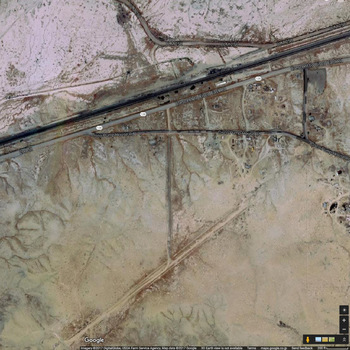 : Google Map Satellite view
: Google Map Satellite view
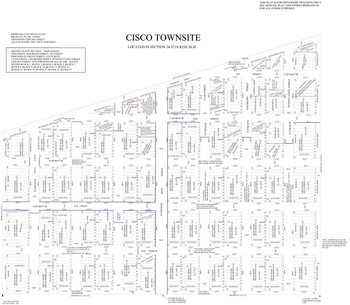 : plat of Cisco Townsite
: plat of Cisco Townsite
View above shows the Colorado Street at Cisco, Utah. How did I come to know the name of such an unbeaten path? The answer is the plat: the Cisco Townsite filed in 1910 survives well into the 21st Century. Here, I represent the joy and value of chasing old plats.
The plat of Cisco Townsite boasts forty-one blocks and fourteen named streets. Streets running north-south on the east side of Main St. are Utah, Colorado and Pennsylvania; on the west side are Lincoln, Sherman, and Grant. Old US Hwy 50&6 along the Rio Grande is, of course, the Railroad Street. Cisco Pump House Road shown in Google Maps running east-west is correctly the Second Street.
But the plat and field of Cisco Townsite today seem unconformable at a glance as you see in Google Map Satellite view shown below. Is the old plat worthless for us today? No; for example, the landowners’ names in the plat are still worthy of note.
The plat has sixteen private landowners’ names. Among them, we can find the historic name, Robert T. Capansky. I already mentioned about him in my Capansky’s Bar, Restaurant and Phillips 66 Gas Station post.
Some other related names are also found. William G. Fuller is a son of historic postmistress Hattie M. Fuller. Jay A. Williams seems the relative of the historic resident John Maynard. Thus, the plat mediates between the field and the history of Cisco.
In conclusion, we can re-establish the spacetime of this ghost town from chasing after the old townsite plat, thanks to accurate register, undisturbed field and continuous history of Cisco.
* Index of Grand County Plat (file 04-0023.pdf has Cisco Townsite);
 : Google Map Satellite view
: Google Map Satellite view : plat of Cisco Townsite
: plat of Cisco Townsite2017-04-07 09:00
コメント(0)
Old Townsite Plat Chase, Part 2 [Column_Cisco Township]
: Main Street, Castleton, Utah
Here, I'm representing the joy and value of chasing old plats.
About thirteen miles south of Cisco at upper Castle Valley, nestles a ghost town of Castleton. The town was first settled in late 1870s or early 1880s, and once boasted businesses like Miller’s Hotel and “Plug Hat” kelly’s Saloon[1]. Post office was established in 1882 and the stage line from Cisco carried daily mail[1]. Even the twenty miles Grand River, Castleton & La Sal Mountain Railroad connecting the vicinity and the Colorado River was established in 1901, but never realized[2].
The town filed the townsite in 1901[3]. Unfortunately, however, in 1967, the Grand County vacated the original townsite. Today, it’s hard to imagine the golden age of the town: only a few lots from that time survive and even the main street slipped off the original plat.
Streets, blocks and lots are gone at Castleton, but the plat retains a few historic names as the landowners. Peter Doles who rests at the private cemetery shown in the plat is the son of Jerry P. and Alice Doles who moved to the town from Arizona in 1956[2]. Susan P. Johnston seems the relative of Alva Johnston who moved from Norwood, Colorado in 1949[4].
Accordingly, the town of Castleton retains accurate register and undisturbed field. With more continuous historical clues, we will be able to re-establish the spacetime of this ghost town.
[1] Firmage, Richard A., (1996) A History of Grand County, Utah State Historical Society
[2] Feb. 2, 1901 Salt Lake Tribune;
[3, 4] Salmon, Rusty, (2004) “Castleton: Turn-of-the-Century Boom Town”, Volume 52, Canyon Legacy, Dan O’Laurie Canyon County Museum
* Index of Grand County Plat (Castleton Townsite at file 04-0023.pdf);
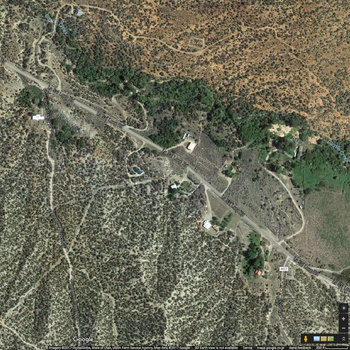 : Google Map Satellite view
: Google Map Satellite view
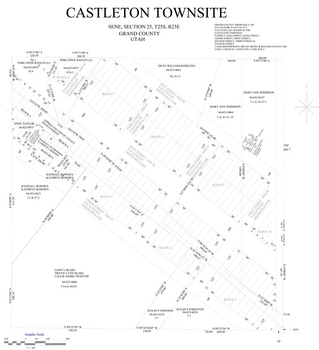 : plat of Castleton Townsite
: plat of Castleton Townsite
Here, I'm representing the joy and value of chasing old plats.
About thirteen miles south of Cisco at upper Castle Valley, nestles a ghost town of Castleton. The town was first settled in late 1870s or early 1880s, and once boasted businesses like Miller’s Hotel and “Plug Hat” kelly’s Saloon[1]. Post office was established in 1882 and the stage line from Cisco carried daily mail[1]. Even the twenty miles Grand River, Castleton & La Sal Mountain Railroad connecting the vicinity and the Colorado River was established in 1901, but never realized[2].
The town filed the townsite in 1901[3]. Unfortunately, however, in 1967, the Grand County vacated the original townsite. Today, it’s hard to imagine the golden age of the town: only a few lots from that time survive and even the main street slipped off the original plat.
Streets, blocks and lots are gone at Castleton, but the plat retains a few historic names as the landowners. Peter Doles who rests at the private cemetery shown in the plat is the son of Jerry P. and Alice Doles who moved to the town from Arizona in 1956[2]. Susan P. Johnston seems the relative of Alva Johnston who moved from Norwood, Colorado in 1949[4].
Accordingly, the town of Castleton retains accurate register and undisturbed field. With more continuous historical clues, we will be able to re-establish the spacetime of this ghost town.
[1] Firmage, Richard A., (1996) A History of Grand County, Utah State Historical Society
[2] Feb. 2, 1901 Salt Lake Tribune;
[3, 4] Salmon, Rusty, (2004) “Castleton: Turn-of-the-Century Boom Town”, Volume 52, Canyon Legacy, Dan O’Laurie Canyon County Museum
* Index of Grand County Plat (Castleton Townsite at file 04-0023.pdf);
 : Google Map Satellite view
: Google Map Satellite view : plat of Castleton Townsite
: plat of Castleton Townsite2017-04-14 09:00
コメント(0)
Old Townsite Plat Chase, Part 3 [Column_Cisco Township]
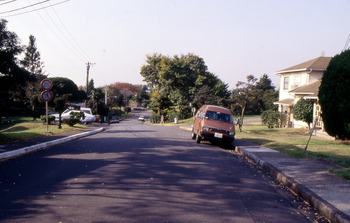 : Nov. 17, 1993. Sky Line Drive and Negishi Avenue, Yokohama, Japan
: Nov. 17, 1993. Sky Line Drive and Negishi Avenue, Yokohama, JapanHere, I'm representing the joy and value of chasing old plats.
Here is another sample of plat/field unconformity. The Google Map Satellite shown below represents housings of U.S. Navy Fleet Activities Yokosuka, Yokohama Detachment, Negishi Dependent Housing Area at the village of Tsukagoshi in Yokohama, Japan. The second drawing shown below is the plat of the same area. Here, the field and the plat are quite unconformable: even the layered map shown below may not convince you.
Actually, the plat proves the village of Tsukagoshi before 1947. The area was requisitioned from the Allied Forces for X Housing Area on Oct. 16, 1947. Before that, the area grew vegetables: July 24, 1947, aerial photo shown below represents the village of Tsukagoshi at that time. As you can see, the field at that time and the plat are consistent.
Accordingly, the village of Tsukagoshi retains accurate register. But it lacks neither undisturbed field nor continuous history. Without these, I think it’s difficult to re-establish the spacetime of this vanished village.
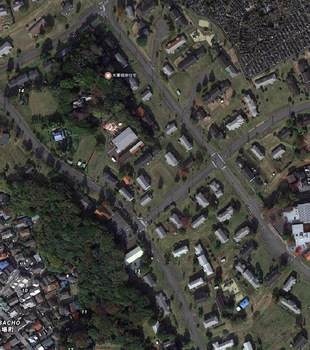 : Google Map Satellite view
: Google Map Satellite view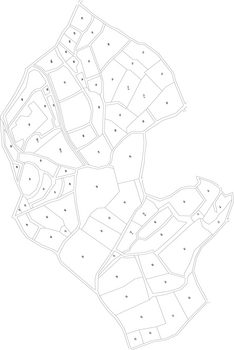 : plat of Tsukagoshi, Yokohama
: plat of Tsukagoshi, Yokohama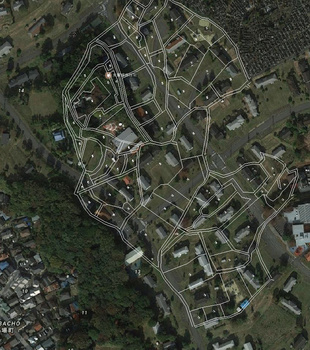 : layered map of the area
: layered map of the area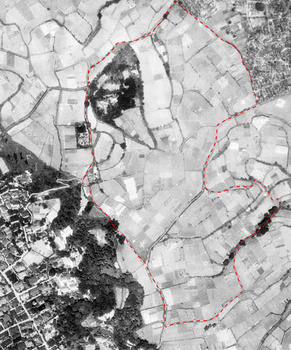 : 1947 aerial photo concerned area shown in red dotted line. Courtesy, Geospatial Information Authority of Japan
: 1947 aerial photo concerned area shown in red dotted line. Courtesy, Geospatial Information Authority of Japan2017-04-21 09:00
コメント(0)
An Expression Derived From Cisco − "Cisco Clifton’s Fillin’ Station", Part 1 [Column_Cisco Township]
Our model and/or layout are pieces of work driven by the phantasm. But the phantasm and the actuality don’t coincide with each other: there is a difference between the two. I think the vitals of our hobby is hidden between the two.
Town of Cisco attracts many to this day in spite of/because of its desolation. The desolation may cause phantasms in callers’ minds. Creators who visited Cisco through the ages produced pieces of work driven by their phantasms. Then, in turn, the pieces of works draw another caller (like me) to Cisco.
But, as always, the phantasm and the actuality aren’t the same here at Cisco. Here, I analyze how the creators remixed actual Cisco to produce their pieces of works to extract the vitals of their creation.
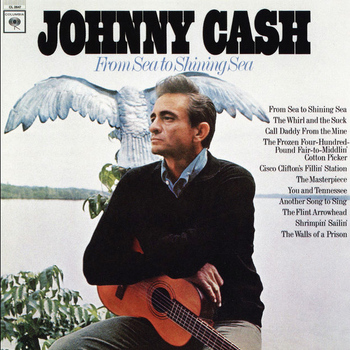 : album, From Sea to Shinning Sea (1968)
: album, From Sea to Shinning Sea (1968)
Cisco Clifton’s Fillin’ Station by Johnny Cash
John Ray “Johnny” Cash (1932 – 2003) was a country music singer-songwriter born in Kingsland, Arkansas. Related to our hobby, he made a TV Special and a song Ridin’ The Rails for Lionel Trains in 1974. His 1975 album Destination Victoria Station, a special product only offered at Victoria Station Restaurant, was consisted of train-related songs. I also remember a photo of him standing with his guitar on the front deck of the L&N locomotive in Trains magazine.
Johnny Cash live recordings database site shows Cash gave performance, every summer from 1960 to 1967, at the Lagoon in Salt Lake City[1]. In 1965 and 1966, his schedule the day before and after Salt Lake City was the performance at Morrison, Colorado Springs, and Denver, Colorado. Why he did not drive US Route 50/6 through Cisco?
According to Weis, indeed, Johnny Cash was a caller at Cisco one day, stayed into the evening, and spent $7.11[2]. Later, he was said to have written a song titled Cisco Clifton’s Fillin’ Station: The song was recorded in Mar/Apr 1967, and released in 1968.
[1] Johnny Cash live recordings database;
[2] Weis, Norman D., (1977) Helldorados, Caxton Printers
Town of Cisco attracts many to this day in spite of/because of its desolation. The desolation may cause phantasms in callers’ minds. Creators who visited Cisco through the ages produced pieces of work driven by their phantasms. Then, in turn, the pieces of works draw another caller (like me) to Cisco.
But, as always, the phantasm and the actuality aren’t the same here at Cisco. Here, I analyze how the creators remixed actual Cisco to produce their pieces of works to extract the vitals of their creation.
 : album, From Sea to Shinning Sea (1968)
: album, From Sea to Shinning Sea (1968)Cisco Clifton’s Fillin’ Station by Johnny Cash
John Ray “Johnny” Cash (1932 – 2003) was a country music singer-songwriter born in Kingsland, Arkansas. Related to our hobby, he made a TV Special and a song Ridin’ The Rails for Lionel Trains in 1974. His 1975 album Destination Victoria Station, a special product only offered at Victoria Station Restaurant, was consisted of train-related songs. I also remember a photo of him standing with his guitar on the front deck of the L&N locomotive in Trains magazine.
Johnny Cash live recordings database site shows Cash gave performance, every summer from 1960 to 1967, at the Lagoon in Salt Lake City[1]. In 1965 and 1966, his schedule the day before and after Salt Lake City was the performance at Morrison, Colorado Springs, and Denver, Colorado. Why he did not drive US Route 50/6 through Cisco?
According to Weis, indeed, Johnny Cash was a caller at Cisco one day, stayed into the evening, and spent $7.11[2]. Later, he was said to have written a song titled Cisco Clifton’s Fillin’ Station: The song was recorded in Mar/Apr 1967, and released in 1968.
[1] Johnny Cash live recordings database;
[2] Weis, Norman D., (1977) Helldorados, Caxton Printers
2017-05-19 09:00
コメント(0)
An Expression Derived From Cisco − "Cisco Clifton’s Fillin’ Station", Part 2 [Column_Cisco Township]
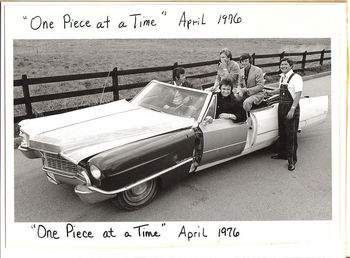 : hodge-podge Cadillac
: hodge-podge CadillacHere, I extract lyrics representing the town and people of Cisco from the song:
Cisco Clifton had a fillin' station
About a mile and a half from town
Regular gas was all that it sold
Except tobacco matches and oil
And once a big black Cadillac
Spent seven dollars there [1]
Who is Cisco Clifton? I’ve never heard of such a resident at Cisco.
According to Jason Fried, Harry Ballard Harris (1914 – 2005, a little over fifty years old then) is the very Cisco Clifton.
Ballard told Jason that he did fill Cash’s car up with seven dollars worth of gas[2]. The average annual gas price in 1966 was 32 Cents per gallon[3]. Accordingly, seven dollars worth of gas makes brimming 22 gallons. Anyway, servicing Johnny Cash’s car is believed to be the honor[4].
Harry Ballard Harris worked for the Utah Department of Transportation between 1946 and 1976. He was stationed at Cisco as a road foreman and initially lived in a house next to Cisco Mercantile on the south at Second Street[5].
He later opened up a gas service station/residence about half a mile west of Cisco on US Route 50/6 in the 50s: his side business first appears in the newspaper dated 1954[6]. After his retirement in 1976, he moved to Dewey, about 14 miles south on Utah State Route 128.
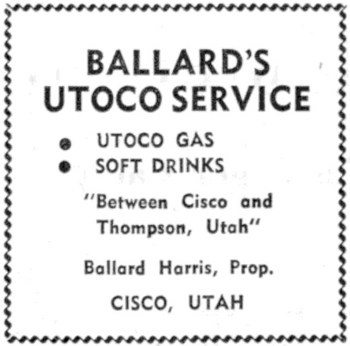 : July 21, 1955 Green River Journal
: July 21, 1955 Green River JournalAccording to Weis again, Johnny Cash listened to the guy who came to operate Cisco’s only general store where Cash spent dollars for beers. At that time, he was going to sell the business and uproot his little children from their hometown as the business dramatically declined against his will. Cash seemed impressed by the pathos of the father. Therefore, the lyrics below must have been derived from this episode:
And Cisco said I hope my kids fed
When they build that interstate
He wouldn’t say so but Cisco knew
That the Interstate was too much to fight
As far as I researched, Cisco’s only general store then was the Cisco Mercantile owned by William Richard Cowger(1889 – 1971). In the late 60s, it was operated by William Woodrow Walker(1918 ー 1984) who indeed had four children. But they resided not in Cisco but in Moab.
Raymond Scott of Cisco Automotive Service and Gerald Spears of Ethel’s Cafe seem also sold beers but they didn’t give up their businesses in those days.
Wava and her spouse Ballard Harris did close their business in 1967. But their children were already married and left Cisco at that time.
The only candidate left was made by Ernest Eugene McCoy (1923 – 1989, a little over forty then). McCoy, the proprietor of the Ruth’s 66 Cafe and the McCoy’s Service Station since 1963, seems assigned his cafe business to Mervin Jack Mills in 1967[7]. Moreover, McCoy did have children: four daughters and three sons[8].
At the end of the song, Cash writes There’s a howdy. The dialect is said to be used in the Southern United States. The former Southerner at Cisco I know is William Cowger and Ray Scott both from Texas.
Accordingly, the very Cisco Clifton does not exist. Then, where did the name Cisco Clifton come from? Weis describes that the last name Clifton was taken from one of the folklore names of the original Cisco town: Clifton Station, Martinsdale, and Book Cliffs[9].
The conclusion is that Johnny Cash seems politely collected the scattered actualities and assembled the unique character like a mosaic work. Cash added a fictional name made of old and new town names to the character to integrate pieces of the actuality he collected. The work is splendid.
But the phantasm he made became somewhat obscure due to its miscellany: it resembles his One Piece at a Time hodge-podge unknown model Cadillac. For example, how old was Cisco Clifton at that time when he met Johnny Cash?
[1] Cash, Johnny (1967) Cisco Clifton’s Fillin’ Station lylics;
[2] Fried, Jason (2004) Road stories, Signal vs Noise;
[3] Average Historical Gasoline Pump Price, U.S. Department of Energy;
[4] Feb. 19, 1976 Times-Independent;
[5] Mary L. Hepperle (2004) “Memories of Cisco”, Canyon Legacy Vol. 51, Dan O’Laurie Canyon County Museum
[6] Oct. 21, 1954 Times-Independent;
[7] Jun. 8, 1967 Times-Independent;
[8] May 26, 2016 Times-Independent;
[9] The name Clifton is also born by a Rio Grande station located 7.5 miles east of Grand Junction, CO along US Route 50/6.
2017-05-26 09:00
コメント(0)
An Expression Derived From Cisco − “Thelma & Louise”, Part 1 [Column_Cisco Township]
Our model and/or layout are pieces of work driven by the phantasm. But the phantasm and the actuality don’t coincide with each other: there is a difference between the two. I think the vitals of our hobby is hidden between the two.
Town of Cisco attracts many to this day in spite of/because of its desolation. The desolation may cause phantasms in callers’ minds. Creators who visited Cisco through the ages produced pieces of work driven by their phantasms. Then, in turn, the pieces of works draw another caller (like me) to Cisco.
But, as always, the phantasm and the actuality aren’t the same here at Cisco. Here, I analyze how the creators remixed actual Cisco to produce their piece of works, to extract the vitals of their creation.
 : Thelma & Louise poster
: Thelma & Louise poster
Thelma & Louise (1991)
directed by Ridley Scott
written by Callie Khouri
director of photography, Adrian Biddle
Thelma & Louise is a road movie following the track of the two from Arkansas through Oklahoma and Colorado to Arizona. But the movie was filmed at several spots around Los Angeles, Bakersfield and Moab, Utah; two scenes were filmed at Cisco in August 1990[1].
A scene is found in the final shooting script by Callie Khouri dated June 5, 1990;
Louise and Thelma blow through a stand of buildings left from when the train went through here. There are two parallel streets on either side of the one they're on and, as they pass by buildings, they can see police cars ROARING down these parallel streets trying to "head them off at the pass." Louise FLOORS it and her car screams ahead[2].
Here, a stand of buildings is of Cisco. Unfortunately, however, they blow through not parallel streets but private properties of Capansky, Vigil, and others; the post office is barely seen behind the dust.
[1] Weller, Sheila (2011) The Ride of a Lifetime, Mar. 2011, Vanity Fair;
[2] Khouri, Callie (1990) “Thelma & Louise” Final Shooting Script;
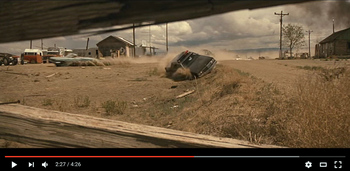
Town of Cisco attracts many to this day in spite of/because of its desolation. The desolation may cause phantasms in callers’ minds. Creators who visited Cisco through the ages produced pieces of work driven by their phantasms. Then, in turn, the pieces of works draw another caller (like me) to Cisco.
But, as always, the phantasm and the actuality aren’t the same here at Cisco. Here, I analyze how the creators remixed actual Cisco to produce their piece of works, to extract the vitals of their creation.
 : Thelma & Louise poster
: Thelma & Louise posterThelma & Louise (1991)
directed by Ridley Scott
written by Callie Khouri
director of photography, Adrian Biddle
Thelma & Louise is a road movie following the track of the two from Arkansas through Oklahoma and Colorado to Arizona. But the movie was filmed at several spots around Los Angeles, Bakersfield and Moab, Utah; two scenes were filmed at Cisco in August 1990[1].
A scene is found in the final shooting script by Callie Khouri dated June 5, 1990;
Louise and Thelma blow through a stand of buildings left from when the train went through here. There are two parallel streets on either side of the one they're on and, as they pass by buildings, they can see police cars ROARING down these parallel streets trying to "head them off at the pass." Louise FLOORS it and her car screams ahead[2].
Here, a stand of buildings is of Cisco. Unfortunately, however, they blow through not parallel streets but private properties of Capansky, Vigil, and others; the post office is barely seen behind the dust.
[1] Weller, Sheila (2011) The Ride of a Lifetime, Mar. 2011, Vanity Fair;
[2] Khouri, Callie (1990) “Thelma & Louise” Final Shooting Script;

2017-06-02 09:00
コメント(0)
An Expression Derived From Cisco − “Thelma & Louise”, Part 2 [Column_Cisco Township]
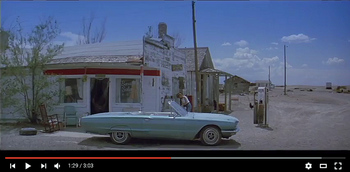 : a scene at youtube
: a scene at youtubeAnother scene is not found in the final shooting script; Louise and Thelma stop for a rest at a deserted town. There, Louise encounters an old man with the white beard and a hat in front of a shack next to the old gas service station/beauty salon, while Thelma pisses at the outhouse across the railroad track. The scene is said to be the idea of Susan Sarandon[1].
Here, a deserted town is Cisco, old gas service station is the Capansky’s by then out of business, outhouse is the former Rio Grande Telephone booth, and the railroad track is the former Rio Grande, by then Southern Pacific.
I think the two scenes have something in common regarding the treatment of Cisco. In both scenes, Cisco is modified. Capansky’s got cosmetic restoration; out of business cafe changed to beauty salon, gas pump moved to another side and faucet added. Fake laundry was hung out between by then vacant Capansky’s and the Tie House. Cars trampled on private properties. So to say, the movie crews made good use of Cisco. In other words, the identity of Cisco is ignored; we cannot recognize the authentic town or the residents of Cisco.
Ridley Scott hired the locals to add a character in his film[2, 3]. The old man appears in the scene above was a Cisco resident Ernest "Ernie" Vonderhoff (1899 – 1995) who was still keeping claims for two already closed mines in Colorado at that time[4, 5, 6]. He won the "Best Delivered Lines" award from the Moab Film Commission by his silent performance with Susan Sarandon[7].
revised, Jan. 14, 2020
[1] Thelma & Louise Trivia web page;
[2] Weller, Sheila (2011) The Ride of a Lifetime, Mar. 2011, Vanity Fair;
[3] Aug. 2, 1990 Times Independent;
[4] D’arc, James V. (2010) When Hollywood Come to Town, Gibbs Smith;
[5] Jun. 13, 1995 Grand Junction Daily Sentinel
[6] The Diggings site;
[7] Dec. 24, 1991 Times Independent;
2017-06-09 09:00
コメント(0)
An Expression Derived From Cisco − “Don’t Come Knocking”, Part 1 [Column_Cisco Township]
Our model and/or layout are pieces of work driven by the phantasm. But the phantasm and the actuality don’t coincide with each other; there is a difference between the two. I think the vitals of our hobby is hidden between the two.
Town of Cisco attracts many to this day in spite of/because of its desolation. The desolation may cause phantasms in callers’ minds. Creators who visited Cisco through the ages produced pieces of work driven by their phantasms. Then, in turn, the pieces of works draw another caller (like me) to Cisco.
But, as always, the phantasm and the actuality aren’t the same here at Cisco. Here, I analyze how the creators remixed actual Cisco to produce their piece of works, to extract the vitals of their creation.
 : Don’t Come Knocking poster
: Don’t Come Knocking poster
Don’t Come Knocking (2005)
directed by Wim Wenders
written by Sam Shepard, Wim Wenders
director of photography, Franz Lustig
Don’t Come Knocking is a road movie tracking an escaped Western movie star Howard Spence from Utah to Montana. The movie was filmed in summer 2003 at Fisher Towers, Arches National Park, Cisco, Salt Lake City, Utah, Elko, Nevada, and Butte, Montana.
At the beginning of the movie, Howard flees by horse from the filming set at probably Fisher Towers. Howard on horseback later shows up at Cisco. Here, he persuades a man at the shack next to the post office, to trade his showy costume with the worn clothes a guy wears[1].
Here in Cisco, everything is odd: the subject and the backdrop lacks any sense of cohesion. Horseback Western hero comes across a parabolic antenna next to the vintage log cabin, fine-haired thoroughbred tied to weathered man’s deserted shack, and brilliant red socks come out from the dusty hero’s boots. Actually, definitions like offbeat comedy, comedy-drama, ironic comedy, sly comedy, and Divine-Comedy were referred to as along with the definition road-movie.
[1] still photo from the scene shot at Cisco;
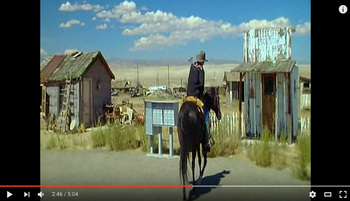
Town of Cisco attracts many to this day in spite of/because of its desolation. The desolation may cause phantasms in callers’ minds. Creators who visited Cisco through the ages produced pieces of work driven by their phantasms. Then, in turn, the pieces of works draw another caller (like me) to Cisco.
But, as always, the phantasm and the actuality aren’t the same here at Cisco. Here, I analyze how the creators remixed actual Cisco to produce their piece of works, to extract the vitals of their creation.
 : Don’t Come Knocking poster
: Don’t Come Knocking posterDon’t Come Knocking (2005)
directed by Wim Wenders
written by Sam Shepard, Wim Wenders
director of photography, Franz Lustig
Don’t Come Knocking is a road movie tracking an escaped Western movie star Howard Spence from Utah to Montana. The movie was filmed in summer 2003 at Fisher Towers, Arches National Park, Cisco, Salt Lake City, Utah, Elko, Nevada, and Butte, Montana.
At the beginning of the movie, Howard flees by horse from the filming set at probably Fisher Towers. Howard on horseback later shows up at Cisco. Here, he persuades a man at the shack next to the post office, to trade his showy costume with the worn clothes a guy wears[1].
Here in Cisco, everything is odd: the subject and the backdrop lacks any sense of cohesion. Horseback Western hero comes across a parabolic antenna next to the vintage log cabin, fine-haired thoroughbred tied to weathered man’s deserted shack, and brilliant red socks come out from the dusty hero’s boots. Actually, definitions like offbeat comedy, comedy-drama, ironic comedy, sly comedy, and Divine-Comedy were referred to as along with the definition road-movie.
[1] still photo from the scene shot at Cisco;

2017-06-30 09:00
コメント(0)
An Expression Derived From Cisco − “Don’t Come Knocking”, Part 2 [Column_Cisco Township]
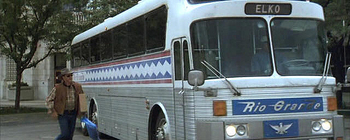
It is said that a comedy is established by substituting the impression. For example, in Buster Keaton’s The General, the Keaton’s tragedy is converted to the farce at the viewers’ mind. Here, I may say that, when we are watching a comedy, we are not absorbed in but distanced from the subject.
Wim Wenders seems also distanced from the subject. He added nothing to Cisco except the casts, and the odd roles and costumes of the casts make them set apart from the backdrop. So to say, Cisco was positively untouched. I think that’s because Wenders respected the unvarnished Cisco. His respect for Cisco even made him releasing a photo of the Cisco post office[1].
By the way, to all my Rio Grande fan readers, motor coach bound for Elko with flying Rio Grande logo is found in the movie[2]. I wonder where this bus came from.
[1] Sep. 16, 2015 Wall Street Journal;
[2] Internet Movie Cars Database web page;
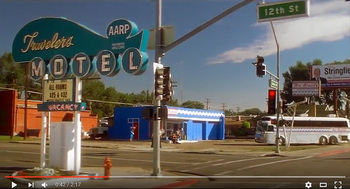
2017-07-07 09:00
コメント(0)
An Expression Derived From Cisco − “Vanishing Point”, Part 1 [Column_Cisco Township]
Our model and/or layout are pieces of work driven by the phantasm. But the phantasm and the actuality don’t coincide with each other: there is a difference between the two. I think the vitals of our hobby is hidden between the two.
Town of Cisco attracts many to this day in spite of/because of its desolation. The desolation may cause phantasms in callers’ minds. Creators who visited Cisco through the ages produced pieces of work driven by their phantasms. Then, in turn, the pieces of works draw another caller (like me) to Cisco.
But, as always, the phantasm and the actuality aren’t the same here at Cisco. Here, I analyze how the creators remixed actual Cisco to produce their piece of works, to extract the vitals of their creation.
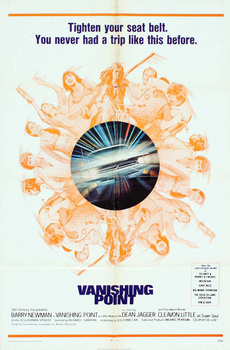 : Vanishing Point poster
: Vanishing Point poster
Vanishing Point (1971)
directed by Richard C. Sarafian
written by Guillermo Cain (Guillermo Cabrera Infante)
director of photography, John A. Alonzo
Vanishing Point is a road movie tracking a car delivery driver Kowalski from Denver west. The movie was filmed in June 1970 in the states of Colorado, Utah, Nevada and California[1, 2]. The opening and ending scenes of the movie were shot here at Cisco, Utah.
Ethel’s Cafe appears in the opening scene behind the title. As the camera pans, deserted Cisco Motel, Mercantile, McCoy’s, Ruth’s and Capansky’s appear in turn after that. By then actual Cisco residents seem also appears in the following cuts. But no one is listed in the end credit roll. Moreover, the name of the place is credited only as CALIFORNIA.
Near the ending scene, the name of the place is revealed as CISCO. It sure is the actual name. It was placed not in Utah but in California; the name of the place is actual but also virtual.
In the ending scene, Kowalski slams his car into bulldozers set on the highway in front of Ethel’s Cafe. In the scene, the car is facing west. But it actually is facing east. The last scene is credited 10:04 A.M. But, considering the sun behind the crashed car, it actually is early in the evening. Accordingly, the opening and ending scenes are the virtual images; as if to say reflected images of actual Cisco. And the name of the place is the sole focal point between the virtual and the actual.
[1] Jun. 11, 1970 Times-Independent;
[2] Jun. 25, 1970 Times-Independent;
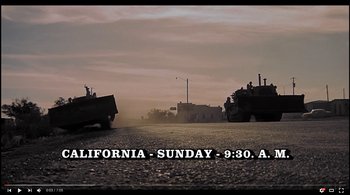
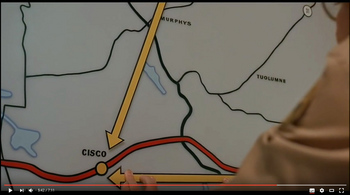
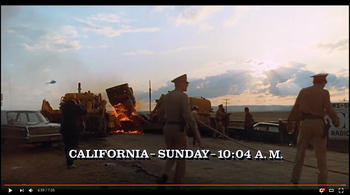
Town of Cisco attracts many to this day in spite of/because of its desolation. The desolation may cause phantasms in callers’ minds. Creators who visited Cisco through the ages produced pieces of work driven by their phantasms. Then, in turn, the pieces of works draw another caller (like me) to Cisco.
But, as always, the phantasm and the actuality aren’t the same here at Cisco. Here, I analyze how the creators remixed actual Cisco to produce their piece of works, to extract the vitals of their creation.
 : Vanishing Point poster
: Vanishing Point posterVanishing Point (1971)
directed by Richard C. Sarafian
written by Guillermo Cain (Guillermo Cabrera Infante)
director of photography, John A. Alonzo
Vanishing Point is a road movie tracking a car delivery driver Kowalski from Denver west. The movie was filmed in June 1970 in the states of Colorado, Utah, Nevada and California[1, 2]. The opening and ending scenes of the movie were shot here at Cisco, Utah.
Ethel’s Cafe appears in the opening scene behind the title. As the camera pans, deserted Cisco Motel, Mercantile, McCoy’s, Ruth’s and Capansky’s appear in turn after that. By then actual Cisco residents seem also appears in the following cuts. But no one is listed in the end credit roll. Moreover, the name of the place is credited only as CALIFORNIA.
Near the ending scene, the name of the place is revealed as CISCO. It sure is the actual name. It was placed not in Utah but in California; the name of the place is actual but also virtual.
In the ending scene, Kowalski slams his car into bulldozers set on the highway in front of Ethel’s Cafe. In the scene, the car is facing west. But it actually is facing east. The last scene is credited 10:04 A.M. But, considering the sun behind the crashed car, it actually is early in the evening. Accordingly, the opening and ending scenes are the virtual images; as if to say reflected images of actual Cisco. And the name of the place is the sole focal point between the virtual and the actual.
[1] Jun. 11, 1970 Times-Independent;
[2] Jun. 25, 1970 Times-Independent;



2017-07-28 09:00
コメント(0)
An Expression Derived From Cisco − “Vanishing Point”, Part 2 [Column_Cisco Township]
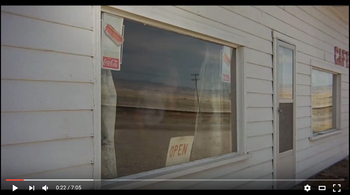
Fakes, dummies, and frauds are the usual practices in our model railroading and are also in movie filming. Without these, we cannot reach our goal. In this movie, we can find another method: reflection.
Reflection is a set of the wave with equal angle: incident and reflected. The well-known effect caused by reflection is an inversion.
As I wrote previously, Cisco scenes are the virtual images. But the virtual images in this movie are the inverted actual images: westbound is actually eastbound and 10:04 A.M. is actually early in the evening. Therefore, Cisco scenes may be considered to be using the method of reflection.
Here is supporting evidence. Throughout the Cisco scenes, the words are few. We can still see the image even if it is inverted, but can’t get the inverted words. Thus, the words are removed from the Cisco scenes.
Here is another supporting evidence. There is no indoor cut throughout the Cisco scenes. Considering the method of reflection, wave incident upon Cisco should not originate at inside, but fall on from the outside.
Window glass reflections obstruct showing indoor views of Cisco Mercantile or Ethel’s Cafe as if Cisco is the sacred place: so to say, actual Cisco is sealed behind the reflections. The ray of light from the gap between the blades of bulldozers in the ending scene is actually the reflection of the sunlight caused by the reflector board set behind the blades: it must be the most sacred reflection in the movie.
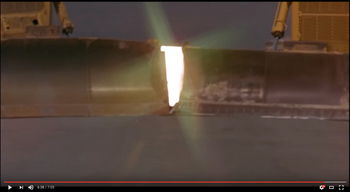
2017-08-04 09:00
コメント(0)
Cisco, Cisco, Cisco, part 1 – Cisco Stations [Column_Cisco Township]
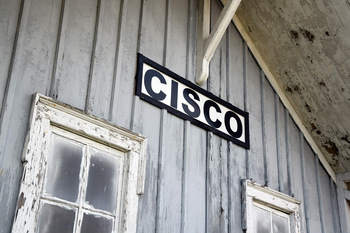 : Cisco, IL. Sep. 11, 2019
: Cisco, IL. Sep. 11, 2019I’m trying to build the N scale replica of the town of Cisco, Utah circa 1970. Accordingly, it’s my routine to search Cisco on the web, but it goes wrong most of the times bothered by “San Francisco” or “Cisco Systems”. Sometimes, “Cisco, Texas” gets in my way. Thus, I was wondering how many “Cisco”s are there in the United States. My recent research during these Stay Home days revealed some of them. Here, let me introduce these places named Cisco as a sideshow for my Town of Cisco posts.
The origin of Cisco as the name of the place is said to be a French Canadian borrowing from Ojibwa for a kind of whitefish of an oily nature, or a boy's name of Spanish meaning Frenchman or free man, and or the cognomen of Francisco.
The Denver & Rio Grande Railway Cisco station, as well as the original community of Cisco, Utah was established in 1883. Here, station means a place on a railroad line where trains regularly stop, while depot means a structure at the station built for agent, passenger, and freight.
The July 1883 Travelers’ Official Railway Guide for the United States and Canada lists four railway stations named Cisco besides new-born Cisco, Utah on D&RG. Those were;
Cisco, CA on Central Pacific Railroad, est. 1865,
Cisco, IL on Wabash, St. Louis & Pacific Railway, est. 1874,
Cisco, OH on Toledo, Cincinnati & St. Louis Railroad, est. 1877, and
Cisco, TX on Houston & Texas Central Railway and Texas & Pacific Railway est. 1881[1].
The following four Cisco stations appear in the Guides issued afterward;
Cisco, NC on Suffolk & Carolina Railway, est. 1891,
Cisco, AK on St. Louis & North Arkansas Railroad, est. 1901,
Cisco, MN on Minneapolis, St. Paul & Sault Ste. Marie Railroad, est. 1903, and
Cisco, GA on Louisville & Nashville Railroad, est. 1905.
Accordingly, we now know that there were nine railroad stations named Cisco in the United States. USGS topological maps, aerial photos, and newspaper archives may suggest to us the heyday of each station/community of Cisco. Each of those will be represented in the following posts.
The photos show the depot at Cisco, IL built more than a hundred years ago: the only surviving Cisco depot to this day.
[1] Allen, W. F., (1883) Travelers’ Official Railway Guide for the United States and Canada, National Railway Publication Company;
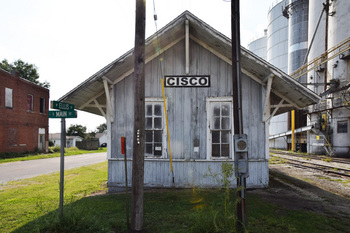 : Cisco, IL. Sep. 11, 2019
: Cisco, IL. Sep. 11, 20192020-07-31 09:00
コメント(0)
Cisco, Cisco, Cisco, part 2 – Cisco, California [Column_Cisco Township]
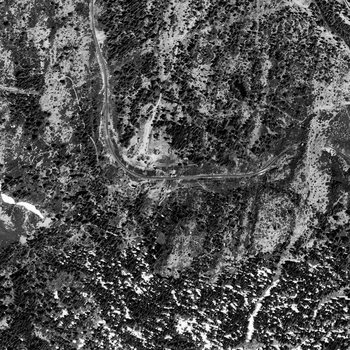 : 1953 USGS Aerial Photo of Cisco, CA
: 1953 USGS Aerial Photo of Cisco, CAI’m trying to build the N scale replica of the town of Cisco, Utah circa 1970. Accordingly, it’s my routine to search “Cisco” on the web, but it goes wrong most of the times bothered by “San Francisco” or “Cisco Systems”. Sometimes, “Cisco, Texas” gets in my way. Thus, I was wondering how many “Cisco”s are there in the United States. My recent research during these Stay Home days revealed some of them. Here, let me introduce these places named Cisco as a sideshow for my Town of Cisco posts.
Cisco, Placer, California: the Central Pacific Railroad’s Cisco station was located in the middle of famed Donner Pass route between Colfax and Truckee; eight miles to Emigrant Gap to the west and fourteen miles to Summit to the east according to the 1883 Official Railway Guide.
The name of the station was changed in 1865 from Heaton(ville) to Cisco honoring John Jay Cisco(1806 – 1884), who was the treasurer of the Central Pacific Railroad resigned a year before, later New York banker, and the assistant Secretary to the Treasury under two Democrats and then under Lincoln[1, 2, 3]. The rail reached Cisco in November 1866[4].
The community was platted of five by five blocks both north and south sides of the track according to the 1870 map[1]. It is said that the original Heaton Station Post Office was established in 1856[5]. But it isn't listed in United States Official Postal Guide nor Official Register of the United States.
The Cisco Post Office was operated between 1866 and 1941[6]. James Heaton(1821 ー 1901) was the original postmaster, succeeded by Daniel Eisner(1825 ー ?) in 1868.
The community also had a hotel and general store[5]. The golden age of the community is recorded in the photo at Society of California Pioneers Collection[7]. Well known huge snow shed and the street of Cisco is captured in the 1920s photo at Placer County Museums[8].
The 1891 USGS map shows some signs of habitat on the north side of the track. Dec. 1952 issue of Trains magazine has a photo of Cisco showing the lone depot structure. The depot is still intact in the 1953 USGS Aerial Photo but is gone by 1970 according to the USGS photo. 1974 photo of Amtrak California Zephyr led by SP SD45 #8983 shows nothing but a shanty at Cisco[9].
Today, the former CP line, later Southern Pacific Railroad and present Union Pacific Railroad line remains active at Cisco. But not a habitat exists today: the name Cisco only survives as the name of the siding on UP Roseville Subdivision, and the name of the adjacent country road.
This place is said to be the setting where Kowalski faced the end in the 1971 movie Vanishing Point, which actually was shot at Cisco, Utah.
[1] Cisco - background, Oct. 2018, #122, The Donner Summit Heirloom, Donner Summit Historical Society;
[2] Mar. 24, 1884 New York Times;
[3] Gudde, Erwin, G., (2010) California Place names, University of California Press;
[4] CPRR/SP Donner Route Timeline, Placer Sierra Railroad Heritage Society;
[5] Towns and Their Histories, Placer County, California genealogy trails;
[6] Forte, Jim, Placer County, California Post Offices, Jim Forte Postal History;
[7] 1259. Upper Cisco, Placer County. Central Pacific Railroad Teams, Society of California Pioneers;
[8] Cisco, and auto tent camp, Pitsenberger’s Adventures in California History;
[9] Schmollinger, Steve, (1974) Amtrak No. 6, Railroad Picture Archives;
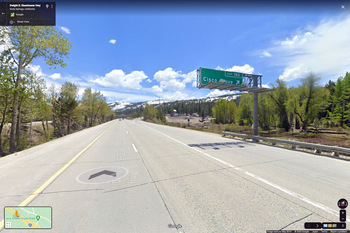 : Google maps of Cisco, CA
: Google maps of Cisco, CA2020-08-07 09:00
コメント(0)
Cisco, Cisco, Cisco, part 3 – Cisco, Illinois [Column_Cisco Township]
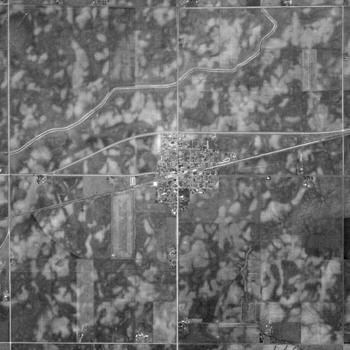 : 1956 USGS Aerial Photo of Cisco, IL
: 1956 USGS Aerial Photo of Cisco, ILI’m trying to build the N scale replica of the town of Cisco, Utah circa 1970. Accordingly, it’s my routine to search “Cisco” on the web, but it goes wrong most of the times bothered by “San Francisco” or “Cisco Systems”. Sometimes, “Cisco, Texas” gets in my way. Thus, I was wondering how many “Cisco”s are there in the United States. My recent research during these Stay Home days revealed some of them. Here, let me introduce these places named Cisco as a sideshow for my Town of Cisco posts.
Cisco, Piatt, Illinois: the Wabash, St. Louis & Pacific Railway’s Cisco, Illinois station was located on the line between Decatur and Monticello; 5.5 miles to Argenta to the west and 3.3 miles to Amenia to the east according to the 1966 Official Railway Guide.
Both the depot and the original plat of Cisco were established in 1874[1]. The plat was named for Francisco Dallas, the mother of Erastus Fletcher Dallas(1838 – 1911) who was the original agent at the depot[2]. However, unfortunately, the passenger service was ended in 1939[3]. The depot structure still exists but remains closed since the 60s. The last agent was Dale Riggins assigned in 1963[1].
The Cisco Post Office was also established in 1874[1]. Oscar Harper(1840 – 1899) was the original postmaster. The recent post office building was built in 1958. The Cisco School was first built in 1885. The schoolhouse was torn down in the late 90s and became the Cisco Fire Department[4]. The village had a population of 379 in 1910 and 257 in 2016.
Today, part of the former WSt.L & P line, later Illinois Central Railroad Decatur District known as “Peanut Line” between Decatur and Cisco is operated by the Decatur Central Railroad managed by Omnitrax. Predecessor Decatur Junction Railway used rebuilt GP16s and GP20u. Decatur Central Railroad uses GP38-2s.
[1] Cisco, Ill. Centennial History Committiee, (1974) Cisco, Illinois, 1874 – 1974;
[2] Callary, Edward, (2010) Place Names of Illinois, University of Illinois Press;
[3] History of the depot in Cisco, Illinois, ciscojunction.com;
[4] Downey, Dennis, (2009) Cisco High School “Wildcats”, Illinois High School Glory Days;
* 2012 photo of unpatched ATSF Gp20u #3069 at Cisco by Zachary Walters at Railroad Picture Archives;
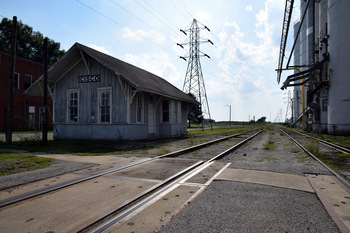 : Cisco, IL. Sep. 11, 2019
: Cisco, IL. Sep. 11, 2019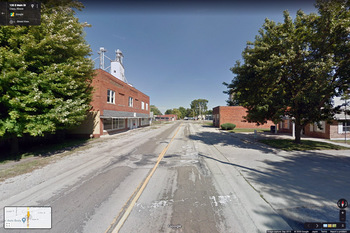 : Google maps Cisco, IL
: Google maps Cisco, IL2020-08-14 09:00
コメント(0)
Cisco, Cisco, Cisco, part 4 – Cisco, Ohio [Column_Cisco Township]
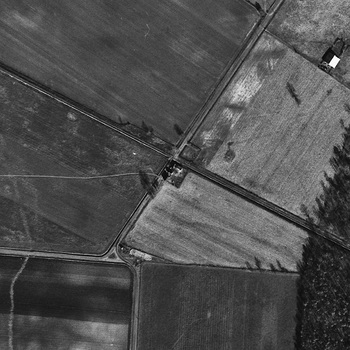 : 1960 USGS Aerial Photo of Cisco, OH
: 1960 USGS Aerial Photo of Cisco, OHI’m trying to build the N scale replica of the town of Cisco, Utah circa 1970. Accordingly, it’s my routine to search “Cisco” on the web, but it goes wrong most of the times bothered by “San Francisco” or “Cisco Systems”. Sometimes, “Cisco, Texas” gets in my way. Thus, I was wondering how many “Cisco”s are there in the United States. My recent research during these Stay Home days revealed some of them. Let me introduce these places named Cisco as a sideshow for my Town of Cisco posts.
Cisco, Fayette, Ohio: the Toledo, Cincinnati & St. Louis Railroad’s Cisco, Ohio station was located between Washington Court House and Frankfort; two miles to Convenience to the west and two miles to Fairview to the east according to the 1883 Official Railway Guide. Grain shipment was the leading role of the station[1].
It is said that the nearby community once had a post office known as the Cisco Post Office[2]. The USGS Feature Detail Report for: McLean lists Cisco as the variant name[3]. 1892 A B C Pathfinder Shipping and Mailing Guide lists the place as Cisco but noted it as "not Post Office" and duplicates it as McLean "Post Office"[4].
The community of McLean was named for a civil engineer James Alexander McLean(1841 – 1913) who offered his land for the railroad right of way[1, 2].
The Dayton & Southeastern Railroad from Dayton to Wellston was incorporated in 1871 and the section in Fayette County through Cisco was completed in 1877[5]. The D&SE merged into Toledo, Delphos and Burlington Railroad in 1881, and the TD&B itself merged with TC&StL in 1882.
Accordingly, the community of Cisco may have been renamed to Mclean in these days. But the name of the station remained as Cisco at least until 1898 according to the Official Guide. Eventually, B&O renamed the station to Mclean in no later than 1919, maybe from the beginning in 1917[6].
James Mclean moved from Washington C. H. to Cisco in 1881[4]. The post office called McLean was established in 1888 and remained in operation until 1928[7]. John S. McAllister was the original postmaster, succeeded by Addie Sue McAdams in 1894.
The Cisco School on Cisco Road was built in 1913 and remained until 1941[8, 9]. The schoolhouse survives to this day as a private home shown far right in the Googlemap street view below. 1960 USGS Aerial Photo shows three structures intact at the railroad station/crossing.
The former TC&St.L line, later Cincinnati, Hamilton & Dayton Railroad Wellston Division since 1883, and eventually Baltimore & Ohio Railroad Renick Branch since 1917 was abandoned in 1973[10]. The right of way was converted to the Tri-County Triangle Trail[11]. Today, the name Cisco survives only as of the name of the adjacent country road.
[1] Dills, R. S., (1881) History of Fayette County, Odel & Mayer, Publishers;
[2] Feb. 11, 1952 Washington Court House Record-Herald;
[3] USGS Feature Detail Report for: McLean;
[4] 1892 A B C Pathfinder Shipping and Mailing Guide, New England Railway Publishing Company;
[5] A Little History of Our Trail, Tri-County Triangle Trail, Inc.;
[6] B&O Western Lines Timetables Corrected January 1, 1919;
[7] Forte, Jim, Fayette County, Ohio Post Offices, Jim Forte Postal History;
[8] Turner, Aaron, Fayette County Schools, Old Ohio Schools;
[9] Jun. 19, 1941 Washington Court House Record-Herald
[10] Cahal, Sherman, Cincinnati, Hamilton & Dayton Railroad, Abandoned;
[11] The Renick Branch, Abandoned Rails;
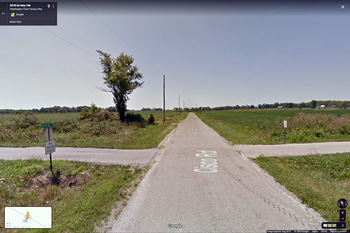 : Google maps Cisco, OH
: Google maps Cisco, OH2020-08-21 09:00
コメント(0)
Cisco, Cisco, Cisco, part 5 – Cisco, Texas [Column_Cisco Township]
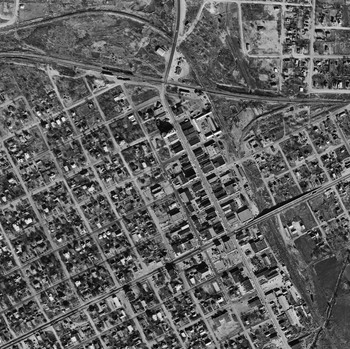 : 1965 USGS Aerial Photo of Cisco, TX
: 1965 USGS Aerial Photo of Cisco, TXI’m trying to build the N scale replica of the town of Cisco, Utah circa 1970. Accordingly, it’s my routine to search “Cisco” on the web, but it goes wrong most of the times bothered by “San Francisco” or “Cisco Systems”. Sometimes, “Cisco, Texas” gets in my way. Thus, I was wondering how many “Cisco”s are there in the United States. My recent research during these Stay Home days revealed some of them. Let me introduce these places named Cisco as a sideshow for my Town of Cisco posts.
Cisco, Eastland, Texas: the Union Passenger Station at Cisco, Texas was located at the crossing of the Houston & Texas Central Railway with the Texas & Pacific Railway between Fort Worth and El Paso; seven miles to Delmar to the west and ten miles to Eastland to the east on T&P according to 1883 Official Railway Guide.
The crossing of the HT&C with the T&P at Eastland County in 1881 attracted the nearby Red Gap inhabitants to move their community to the crossing[1]. When the townsite was platted the same year, it was named for John Jay Cisco: yes, the same person appeared in the history of Cisco, CA. John was a financier of the H&TC at that time. The Cisco Post Office was also granted the same year[2]. Former Red Gap postmaster William Thomas Caldwell(1833 – 1912) was the original postmaster.
The city was once called the "Gate City of the West"[3]. The two-storied red brick Mobley Hotel built in 1916, as you can see in the Googlemaps street view below, is the epicenter of the Hilton Hotels & Resorts founded in 1919: it’s the first property Conrad Nicholson Hilton (1887 – 1979) purchased and managed[3]. The city boasted a population of 7422 in 1920.
The former H&TC line, eventually Missouri-Kansas-Texas Railway line at Cisco was abandoned in 1967[1]. Missouri Pacific through passenger service #1 and 2, the Texas Eagle between St. Louis and El Paso, serving Cisco was discontinued in March 1967[4]. In 2010, the population was 3899.
Today, the former T&P line, later MP and today's Union Pacific Railroad line remains active at Cisco. The Union depot is long gone: the preserved UP caboose #25223 is the only clue to the depot site.
[1] Interlocking Tower 160 – Cisco, Texas web page;
[2] 1984 National Register of Historic Places Inventory-Nomination Form, Cisco Historic District;
[3] Wiggins, Noel, (2010) Cisco, TX, The Handbook of Texas Online, Texas State Historical Association;
[4] Harris, Chuck, (1998) Aboard Missouri Pacific’s last Passenger Train in Texas, Arkansas Railroad History home page;
* 1962 photo of the Union Station;
* photo of the Union Station maybe taken in the 50s;
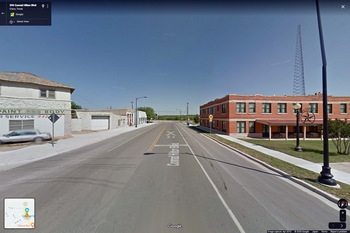 : Google maps Cisco, TX
: Google maps Cisco, TX2020-08-28 09:00
コメント(0)
Cisco, Cisco, Cisco, part 6 – Cisco, North Carolina [Column_Cisco Township]
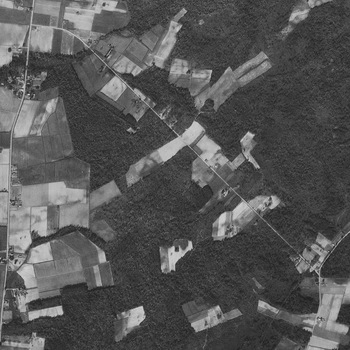 : 1950 USGS Aerial Photo of Cisco, Cisco Road, and Cisco station site, NC
: 1950 USGS Aerial Photo of Cisco, Cisco Road, and Cisco station site, NCI’m trying to build the N scale replica of the town of Cisco, Utah circa 1970. Accordingly, it’s my routine to search “Cisco” on the web, but it goes wrong most of the time bothered by “San Francisco” or “Cisco Systems”. Sometimes, “Cisco, Texas” gets in my way. Thus, I was wondering how many “Cisco”s are there in the United States. My recent research during these Stay Home days revealed some of them. Let me introduce these places named Cisco as a sideshow for my Town of Cisco posts.
Cisco, Chowan, North Carolina: the Suffolk & Carolina Railway’s Cisco, NC station was located between Suffolk, VA and Edenton, NC: Center Hill station to the north and Maraton station to the south according to the Sixth Annual Report of the North Carolina Corporation Commission (1904)[1]. Shipping forest products out of the sawmill was the leading role of the station[2, 3].
The S&C was founded in 1884 and the section through Cisco was completed in 1891[1]. The station was renamed to Beverly no later than 1904[1].
The community of Cisco was located a mile and a half northwest of the station along Virginia Road at GPS coordinates 36.203161, -76.659369. I couldn’t find the origin of the name of Cisco. Cisco Road from the Cisco station reached the community.
The Cisco Post Office was operated between 1891 and 1907[4]. Zachariah Winborne Evans(1861 ー 1937) was the original and the only postmaster. I couldn’t find where the post office was, but the 1891 Site of Location for Cisco Post Office paper suggests it was located within the community along Virginia Road.
Cisco once boasted a cotton gin, a lumber mill, and a general store all managed by the postmaster Evans, a physician's office run by James R. Parker, and a blacksmith/repair shop operated by W. J. Dales[2, 5]. A school was open at least between 1902 and 1943: it was located a mile northeast of the station along Sandy Ridge Road[2, 6].
The S&A eventually merged into the original Norfolk Southern Railway in 1906, but the line was abandoned in 1940[7]. The name of the place where the station was located returned to Cisco and the original Cisco community lost its name[6]. Both communities of original Cisco and former Beverly keep several inhabitants to this day.
revised, Dec. 23, 2022
[1] Lewis, J.D., North Carolina Railroads – Suffolk & Carolina Railway, North Carolina Railroads;
[2] The North Carolina Year Book 1902, The news and Observer;
[3] Office of E. Z. Evans letterhead, East Carolina University Digital Collections;
[4] Forte, Jim, Chowan County, North Carolina Post Offices, Jim Forte Postal History;
[5] Apr. 9, 1897 Fisherman and Farmer;
[6] 1943 USGS map, Edenton, NC
[7] A Belief History of the Norfolk Southern;
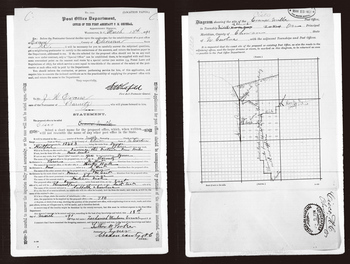 : 1891 Site of Location for Cisco Post Office
: 1891 Site of Location for Cisco Post Office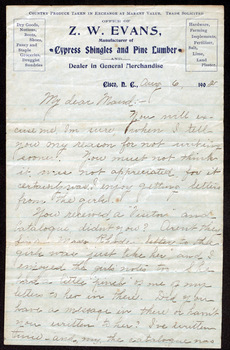 : Office of E. Z. Evans letterhead
: Office of E. Z. Evans letterhead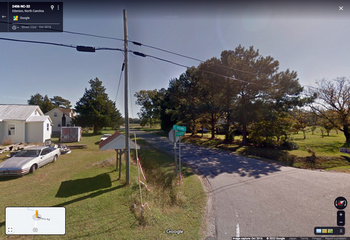 : Google maps, Cisco, NC
: Google maps, Cisco, NC2020-09-04 09:00
コメント(0)
Cisco, Cisco, Cisco, part 7 – Cisco, Arkansas [Column_Cisco Township]
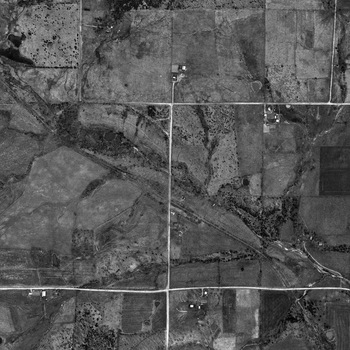 : 1970 USGS Aerial Photo of Cisco, AR
: 1970 USGS Aerial Photo of Cisco, ARI’m trying to build the N scale replica of the town of Cisco, Utah circa 1970. Accordingly, it’s my routine to search “Cisco” on the web, but it goes wrong most of the times bothered by “San Francisco” or “Cisco Systems”. Sometimes, “Cisco, Texas” gets in my way. Thus, I was wondering how many “Cisco”s are there in the United States. My recent research during these Stay Home days revealed some of them. Let me introduce these places named Cisco as a sideshow for my Town of Cisco posts.
Cisco, Carroll, Arkansas: the St. Louis & North Arkansas Railroad’s Cisco station was located on the line from Seligman, MO to Little Rock, AR: eight miles to Freeman to the west and four miles to Green Forest to the east according to the 1908 Official Railway Guide.
The StL&NA was incorporated in 1899 and the line from Seligman, MO reached Harrison, AR in 1901[1]. The station was established the same year as the shipping point for the forest products including crossties[2]. The station was a flag-stop, equipped with a mail crane, but without a telegraph office[3].
The station originally had a name of Braswell Switch: a mile to the east was a community of Braswell Springs[2, 4]. The house/academy was built near the station by William Denson "professor" Crawford(1865 – 1952) in 1900. The Crawford's Academy was operated between 1901 and 1904[2].
In 1903, Isaac S. “Ike” Norton(1863 – 1925) established a post office attached to his general store at the railroad station which he named Cisco[2]. The name of the station was thus changed to Cisco the same year. It is said that Ike named the post office for a historic pioneer family of Carroll County named Cisco/Sisco[5]. The Cisco Post Office lasted until 1949[6]. The sixth and the last postmaster was Albert Dunlevy Buell(1884 - 1966) since 1914[6].
In 1920, there was a grist mill and store/post office, both ran by Buell, and his residence at the north side of the Station[5, 7, 8]. On the south side was a store managed by John William Duncan(1854 ー 1936)[5]. A canning factory was established by John Crittenden Hayes(1864 ー 1931) in 1924[5].
However, unfortunately, the St.L&NA, later the Missouri & North Arkansas Railroad, and eventually the Missouri & Arkansas Railway line through Cisco was abandoned in 1946. The 66 miles portion of the line between Harrison, AR, and Seligman, MO through Cisco was reorganized as Arkansas & Ozarks Railway, but it was also abandoned in 1961 after the 1960 washout[9].
Today, the limestone wall of the Academy remains at GPS coordinates 36.383392, -93.496983 is the only Cisco survivor[10]. The County Road 601 from Berryville east still bears the name Cisco Road.
[1] Mosenthin, H., Glenn, (2019) Missouri and North Arkansas Railroad, Encyclopedia of Arkansas;
[2] National register of Historic Places Registration Form, United States Department of Interior National Park Service;
[3] 1927 Missouri & North Arkansas Railroad timetable;
[4] USGS Feature Detail Report for: Cisco;
[5] History of Cisco, CarrollCountyAR.com;
[6] Forte, Jim, Carroll County, Arkansas Post Offices, Jim Forte Postal History;
[7] Sister---Three, (2017) Little Man To The Rescue, 3 Sisters Family History;
[8] Shiloh Museum of Ozark History web page;
[9] Muskopf, Scott, (2017) Arkansas & Ozarks Railway, Trains & Railroads of the Past;
[10] W. D. Crawford House, LandmarkHunter.com;
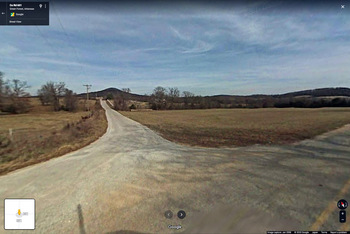 : Google maps, Cisco, AK
: Google maps, Cisco, AK2020-09-11 09:00
コメント(0)
Cisco, Cisco, Cisco, part 8 – Cisco, Minnesota [Column_Cisco Township]
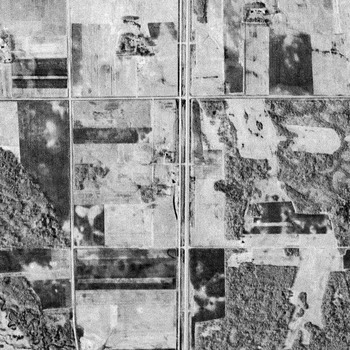 : 1953 USGS Aerial Photo of Cisco, MN
: 1953 USGS Aerial Photo of Cisco, MNI’m trying to build the N scale replica of the town of Cisco, Utah circa 1970. Accordingly, it’s my routine to search “Cisco” on the web, but it goes wrong most of the times bothered by “San Francisco” or “Cisco Systems”. Sometimes, “Cisco, Texas” gets in my way. Thus, I was wondering how many “Cisco”s are there in the United States. My recent research during these Stay Home days revealed some of them. Let me introduce these places named Cisco as a sideshow for my Town of Cisco posts.
Cisco, Polk, Minnesota: Minneapolis, St. Paul & Sault Ste. Marie Railway’s Cisco station was located on the line between Mahnomen, MN and Thief River Falls, MN: four miles to Erskine to the south and four miles to Brooks to the north according to the Soo Line Map of Minnesota[1].
The MStP&SSM(Soo Line) Winnipeg line from Glenwood, MN to Noyes, MN was completed in 1903[2]. The Cisco station established the same year was a water stop and a siding near the border of Polk County and Red Lake County at GPS coordinates 47.742626, -96.001897.
The first settlers came to this region in 1883[3]. The community of Cisco first appears in 1919 USGS map Valley, MN with a small townsite along the railroad. The former landowner of the townsite and the adjacent railroad ROW was Bjelland family[4].
The particular land is registered as owned by Tri State Land Co. of Minneapolis in the 1915 Atlas of Polk County, Minnesota[5]. Tri State Land Co. was the Soo Line's townsite subsidiary[6]. But the townsite itself isn't shown yet in the 1915 Atlas. Accordingly, Cisco townsite was established between 1915 and 1919. The 750 feet square townsite was divided into four blocks with North-South Railway St, Main St, First St, and East-West Maple Ave, Central Ave, and Pine Ave[7].
Tri State Land Co. named thier townsites for an agent of the railroad, a pioneer settler, a merchant, and a former home in Denmark of the pioneer settler in North Dakota[8]. So, the situation must have been pretty similar here in Minnesota. However, unfortunately, I couldn't find the origin of the name of Cisco.
The D. S. B. Johnston Land Co. of St. Paul(Daniel Sidney Bartholomew Johnston, 1832 − 1914) established in 1885, bought the land surrounding the townsite from the Tri State in the late 1910s and recruited the following settlers. However, unfortunately, the company was dismissed in 1943[9]. The townsite itself disappears in 1952 USGS map Grand Forks, ND.
The Cisco Post Office was operated only between 1904 and 1907 on Bjelland's land at GPS coordinates 47.7388889, -96.0005556[10, 11]. The post office was attached to the general store. Bertil Johan Evensen Bjelland(1877 ー ?) was the original postmaster. Andre(w) Nelson Seter(1859 ー 1937) succeeded Bertil in 1906.
The Cisco School (District 146) located east of the post office also on Bjelland's land at GPS coordinates 47.738723, -95.998366 continued at least from 1902 to 1927[4, 12, 13]. After the closure, the schoolhouse was moved to Marcoux Corner on US Hwy 2 and became a tavern/bar Marcoux Corner Bar operated until 2001[14]. However, unfortunately, the structure was burnt down shortly thereafter.
Today, nothing but the railroad track remains of the community of Cisco, MN.
[1] 1915 Soo Line Map of Minnesota;
[2] Kohlin, Ron, (1999) A 100-year Timeline History of The Soo Line Railroad, Ron’s Rec Room;
[3] Aug. 2010 Giving Glory to God for 125 Years, Volts and Jolts;
[4] Map, Badger Township, Polk County, 1902, Historic Map Works;
[5] 1915 Atlas of Polk County, Minnesota, Webb Publishing;
[6] National Register of Historic Places Multiple Property Documentation Form for Archaeological and Historic Resources of Sheridan County, Montana, United State Department of Interior, National park Survice;
[7] 1930 Standard Atlas of Polk County, Minnesota;
[8] Williams, Mary Ann Barnes, (1966) Origins of North Dakota Place Names, Bismark Tribune;
[9] Mar. 17, 2012 Park Rapid Enterprise;
[10] Forte, Jim, Polk County, Minnesota Post Offices, Jim Forte Postal History;
[11] Feature Detail Report for: Cisco Post Office (historical), USGS;
[12] Cisco School-Cisco, Minn.-1921, Polk County 1970, Minnesota, Title Atlas Company;
[13] Former Site of Marcoux Corner Bar;
[14] Lake Pleasant Township, Red Lake County, Minnesota, Wikipedia;
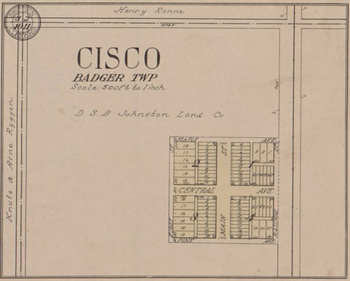 : 1930 townsite of Cisco
: 1930 townsite of Cisco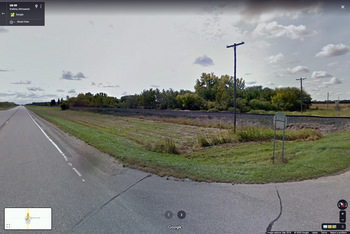 : Google maps, Cisco, MN
: Google maps, Cisco, MN2020-09-18 09:00
コメント(2)
Cisco, Cisco, Cisco, part 9 – Cisco, Georgia [Column_Cisco Township]
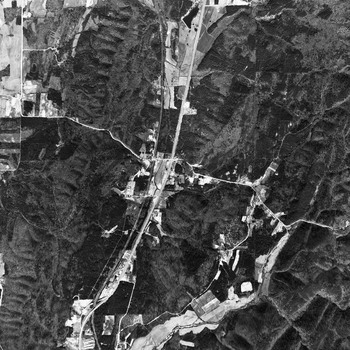 : 1966 USGS Aerial Photo of Cisco, GA
: 1966 USGS Aerial Photo of Cisco, GAI’m trying to build the N scale replica of the town of Cisco, Utah circa 1970. Accordingly, it’s my routine to search “Cisco” on the web, but it goes wrong most of the times bothered by “San Francisco” or “Cisco Systems”. Sometimes, “Cisco, Texas” gets in my way. Thus, I was wondering how many “Cisco”s are there in the United States. My recent research during these Stay Home days revealed some of them. Let me introduce these places named Cisco as a sideshow for my Town of Cisco posts.
Cisco, Murray, Georgia: the Louisville & Nashville Railroad’s Cisco station was located in the northernmost part of the Murray County near the TN/GA border, along the line from Cincinnati to Atlanta between Chatsworth station to the south and Eton station to the north. The station was established in 1905 and the line was completed in 1906[1, 2]. Shipping lumbers out of the sawmill was the leading role of the station[3, 4].
A settlement was established in 1834 by John(1799 ー 1872) and Nancy(1820 ー 1904) Cockburn, preceding the railroad[5]. Their daughter Mary Elvira "Cis/Ciss" Cockburn(1849 ー 1941) ran a store at the settlement: Cis was her nickname. Accordingly, the place was referred to as Cis Cockburn's Store/Cisco[5, 6].
The Cisco Post Office was established in 1881, also preceding the railroad[7]. Marcus Montreville Howell Sr.(1854 ー 1931) was the original postmaster, succeeded by William D Petty(1834 ー 1917) in 1889.
The Cisco School was established in 1904 and operated until 1956[3, 8]. Land for the school was donated by Nancy Cockburn[9]. Both the original post office and the two-rooms schoolhouse built in 1924 are preserved at the community by the efforts of Jack Graves Clayton(1919 ー 2006)[9, 10, 11].
After the completion of the railroad, people came to gather by the depots from the Alaculsey Valley. In the early 1900s after the completion of the railroad, the community boasted of Clayton’s store, Kendrick’s store, Headrick’s feed store, Phillips’ mill, Dalton’s blacksmith shop, and Brownlee’s saw mill[3, 12].
Today, the former L&N line, present CSX Etowah Subdivision remains active but the station is long gone. The community of Cisco boasts the Cisco Post Office, two Churches, and the Cisco Mart convenience store. Carmeuse’s Filler Products-Cisco Mine, producing crushed stone, is located half a mile west of the community.
[1] A Brief Chronology of Murray County’s History, Murray County Museum;
[2] Smith, Robert Neil, (2015) An Evil Day in Georgia, University of Tennessee Press;
[3] Higdon, Charles W., (2014) Cisco Murray County, Georgia;
[4] 1905 photo of the station, Murray County Museum;
[5] Krakow, Kenneth K., (1975) Georgia Place-Names: Their History and Origins, Winship Press;
[6] photo of Mary Cockburn, Murray County Museum;
[7] Forte, Jim, Murray County, Georgia Post Offices, Jim Forte Postal History;
[8] Cisco School, LandmarkHunter.com;
[9] Mary Elvira “Ciss” Cockburn, findagrave.com;
[10] Old Cisco Post Office, LandmarkHunter.com;
[11] Oct. 17, 2006 Dalton Daily Citizen;
[12] 1919 photo of the community of Cisco, Georgia Archives;
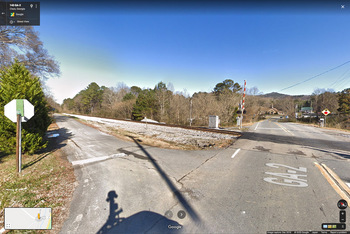 : Google maps, Cisco, GA
: Google maps, Cisco, GA2020-09-25 09:00
コメント(0)
Cisco, Cisco, Cisco, part 10 – Cisco Post Offices [Column_Cisco Township]
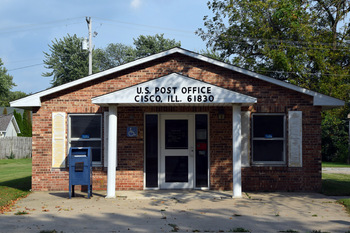 : Cisco, IL. Sep. 11, 2019
: Cisco, IL. Sep. 11, 2019I’m trying to build the N scale replica of the town of Cisco, Utah circa 1970. Accordingly, it’s my routine to search “Cisco” on the web, but it goes wrong most of the times bothered by “San Francisco” or “Cisco Systems”. Sometimes, “Cisco, Texas” gets in my way. Thus, I was wondering how many “Cisco”s are there in the United States. My recent research during these Stay Home days revealed some of them. Let me introduce these places named Cisco as a sideshow for my Town of Cisco posts.
A post office generally bears the name of the place it exists. Accordingly, it may not strange bringing historical post offices up here as the material for our further research.
Historical United States Official Postal Guide published occasionally and Official Register of the United States published every two years lists several post offices named Cisco.
The 1859 United States Official Postal Guide lists none, but the 1870 United States Official Postal Guide lists the single post office named Cisco at Placer County in California[1]. That's the one we discussed in the previous post.
The 1879 United States Official Postal Guide lists two at
Cisco, Placer, California, and
Cisco, Piatt, Illinois[2].
The 1887 Official Register of the United States lists six Cisco/Cisko Post Offices including new-born Cisco, Utah Post Office[3]. Those are;
Cisco, Placer, CA est. 1866,
Cisco, Piatt, IL, est. 1874,
Cisco, Murray, GA, est. 1881,
Cisco, Eastland, TX, est. 1881,
Cisko, Ritchie, WV, est. 1886, and
Cisco, Emery, UT, est. 1887(Grand County was founded three years later in 1890).
The following Cisco Post Offices appear in the Guides and Registers issued afterward;
Cisco, Livingston, MO, est. 1888,
Cisco, Chowan, NC, est. 1891,
Cisco, Mecklenburg, VA, est. 1893,
Cisco, Mcminn, TN, est. 1901,
Cisco, Magoffin, KY, est. 1902,
Cisco, Carroll, AR, est. 1903,
Cisco, Polk, MN, est. 1904,
Cisco, Vilas, WI, est. 1908, and
Cisco, McCurtain, OK, est. 1913.
We already had overviews of the communities of Cisco, AR, CA, GA, IL, MN, NC, and TX in previous posts. After this, we will continue to see Cisco, KY, MO, OK, TN, WI, VA, and WV: communities without Cisco Station but with Cisco Post Offices.
Rural post offices are mostly too small to identify in the aerial photos. So, the USGS or other historical maps and documents will be the main research materials to extract the historical post offices and the communities of Cisco.
[1] 1870 United States Official Postal Guide, United States Post Office Department;
[2] 1879 United States Official Postal Guide, United States Post Office Department;
[3] 1887 Official Register of the United States, United States Department of the Interior;
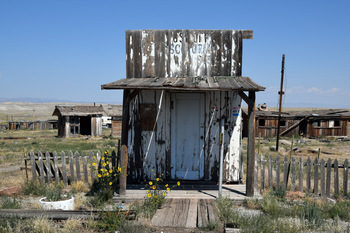 : Cisco, UT Sep. 11, 2014
: Cisco, UT Sep. 11, 20142020-10-09 09:00
コメント(0)
Cisco, Cisco, Cisco, part 11 – Cisco, West Virginia [Column_Cisco Township]
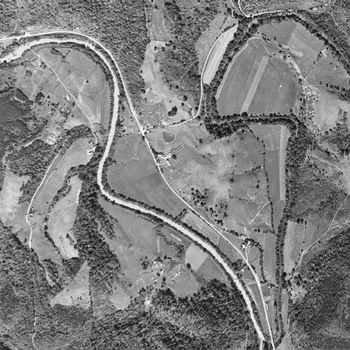 : 1957 USGS Aerial Photo of Cisco, WV
: 1957 USGS Aerial Photo of Cisco, WVI’m trying to build the N scale replica of the town of Cisco, Utah circa 1970. Accordingly, it’s my routine to search “Cisco” on the web, but it goes wrong most of the times bothered by “San Francisco” or “Cisco Systems”. Sometimes, “Cisco, Texas” gets in my way. Thus, I was wondering how many “Cisco”s are there in the United States. My recent research during these Stay Home days revealed some of them. Let me introduce these places named Cisco as a sideshow for my Town of Cisco posts.
Cisco, Ritchie, West Virginia: the post office at Cisco, WV was located on the border of Ritchie County and Wirt County along the Hughes River at GPS coordinates 39.1286895 -81.285608[1]. Cairo-Cisco Road extended southwest from Cairo reached the community. The leading role of the region was oil and gas production.
The community of Cisco was named for Henry Lancisco “Cisko” Jackson(1838 – 1900) who was the proprietor of the general store[2]. Cisko Post Office, also named for Henry, was operated between 1886 and 1909[3]. Henry's nephew, Thomas Hart Benton Jackson(1861 – 1935) was the original postmaster. Henry’s grandson, Stokewell Jackson “Stokely” Enoch(1883 – 1925) was the last postmaster between 1905 and 1909.
The Buffalo School, the nearest school from the post office, at the mouth of Buffalo Run on Cairo-Cisco Road was at least open between 1911 and 1939 at GPS coordinates 39.134245, -81.273727. It burnt to the ground in the late 60s long after its closure[4]. The school appears in 1924 USGS topological map[5].
In 1891, besides Henry's general store/post office operated by Franklin H. Cain(1857 – 1937) since 1889, Cisco boasted of another general store by H. J. Ross, two blacksmith shops by Peter Lytle and Andrew Shepard, a shoe store by Robert Heeter, a sawmill by Issac James, and a corn mill by J. M. McCormick[6].
Henry's grandson, “Stokely” Enoch and Henry's nephew, Charles Ashley Marshall(1880 – 1952) operated the former Henry’s store from the early 1910s[2]. Lionel Leaman Gill(1879 – 1969), the proprietor of the grocery store since circa 1920, sold the grocery to Charles in circa 1925[4]. However, unfortunately, it was burnt to the ground in 1938. Charles therefore moved the store to Cisco-Cairo Road, opposite his home.
Edison Clay(1923 – 2008) and Celia Elizabeth Ownby(1923 – 2009) Kuhn owned and operated the former Henry’s store as Dutches Grocery Store for 18 years[7]. Kenneth and Joyce Moler purchased the store from Edison’s son Dutch E. Kuhn in the 70s and operated it as the J&K’s[8]. Kenneth’s brother James S. "Jim" and Rebecca J. "Becky" Moler succeeded the business in the 80s.
The name of the community changed from Cisko to Cisco in 1949 USGS map, but returned to Cisko in 1961, and changed again to Cisco in 1981[9].
A covered bridge crossing North Fork in front of the Henry's store survived until 1950: substitute steel through truss bridge was built in 1931[10, 11]. I believe this is when the backyard of Henry's store became the storefront.
The nearest rail connection with Cisco used to be the B&O Parkersburg branch at Petroleum about four miles north of Cisco. But the line was abandoned in 1987. The right of way became North Bend Rail Trail[12]. The “loneliest highway”, US Hwy 50 parallels the Trail.
The narrow gauge Cairo & Kanawha Valley Railroad, established in 1890 and operated until 1929, ran along the Cairo-Cisco Rd from Cairo, but never reached Cisco. The Little Kanawha Railroad, established in 1896 and operated until 1933, ran along the namesake river from Parkersburg to the mouth of Hughes River, but never reached Cisco.
Today, The Buffalo Methodist Protestant Church established in 1897 and rebuilt after 1953, and the former Henry's store structure still remain at Cisco.
revised, Oct. 21, 2020
[1] Feature Detail Report for: Cisco, USGS;
[2] Brake, Perry, (2013) Descendants of Jakob Brechtel, Family Tree Maker;
[3] Forte, Jim, Ritchie County, West Virginia Post Offices, Jim Forte Postal History;
[4] Metz, Lorene Cox, (1984) They Came Here..., deemfamily.com;
[5] Feature Detail Report for: Buffalo School (historical), USGS;
[6] West Virginia State Gazetter and Business Directory 1891-92, R. L. Polk & Co.;
[7] Edison Clay Kuhn Obituary, tributes.com;
[8] Six, Dean, (2019) Cisco, Cairo WV History;
[9] USGS TopoView web site;
[10] photo of the covered bridge;
[11] North Fork Hughes River Bridge, Bridgehunter.com;
[12] North Bend Rail Trail, West Virginia State parks;
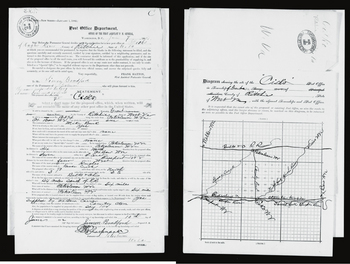 : 1882 Report of Site Location for Cisko Post Office
: 1882 Report of Site Location for Cisko Post Office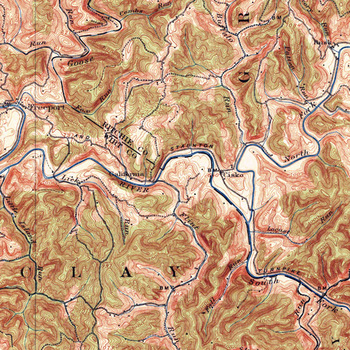 : 1906 USGS map Elizabeth, WV
: 1906 USGS map Elizabeth, WV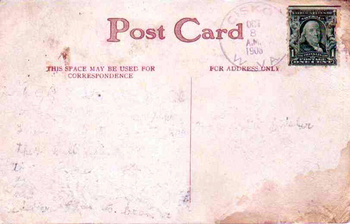 : 1908 Cisko postmark
: 1908 Cisko postmark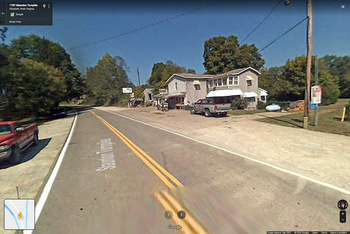 : Google maps, Cisco, WV
: Google maps, Cisco, WV2020-10-16 09:00
コメント(0)
Cisco, Cisco, Cisco, part 12 – Cisco, Missouri [Column_Cisco Township]
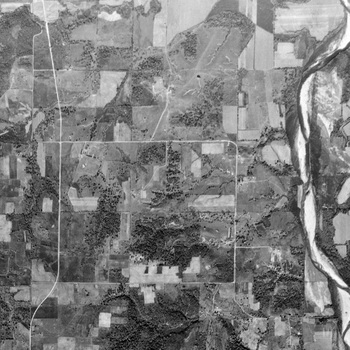 : 1950 USGS Aerial Photo showing the part of Livingston County, MO
: 1950 USGS Aerial Photo showing the part of Livingston County, MOI’m trying to build the N scale replica of the town of Cisco, Utah circa 1970. Accordingly, it’s my routine to search “Cisco” on the web, but it goes wrong most of the times bothered by “San Francisco” or “Cisco Systems”. Sometimes, “Cisco, Texas” gets in my way. Thus, I was wondering how many “Cisco”s are there in the United States. My recent research during these Stay Home days revealed some of them. Let me introduce these places named Cisco as a sideshow for my Town of Cisco posts.
Cisco, Livingston, Missouri: the post office at Cisco, MO was located in the home of the postmaster at the northwest section of the Livingston county near the Grundy County border[1, 2]. It was later moved to the ground owned by James Lafayette Walls(1849 − 1927) at GPS coordinates 39.94112, -93.64575[3]. The leading role of the region was farming. The nearest rail connection with Cisco was the Chicago, Rock Island & Pacific at Hickory Creek located seven miles north of the post office.
The Cisco Post Office was operated between 1888 and 1901[4]. Lyda Hosman(1864 – 1936) was the original and the sole postmaster[5]. He also operated a small store[2].
It is said that the name Cisco came from Texas, bounded up with the coming of the railroads[6]. But the history of this place can date back to the 1850s when Cisco, Texas wasn't established yet.
The nearby school was open at least from 1868[2]. The school was originally called Oak Grove District 1[7]. It is said that there was a controversy over whether it should be called Lauderdale or Hosman when the school was renewed in circa 1874[7].
Robert V. Lauderdale(1860 – 1902) was the landowner of the new school ground at GPS coordinates 39.94696, -93.64298[8]. James “Jas” Hosman(1825 ー 1906), the landowner opposite the school might have offered the schoolhouse: James' son, Lyda Hosman took the old schoolhouse as a trade-in[7]. Eventually, Hosman School was the conclusion.
The schoolhouse burnt to the ground in 1923[7]. It was immediately rebuilt same year at GPS coordinates 39.939736, -93.631328, and was continued until 1957[2, 9]. The schoolhouse burnt again to the ground after the closure in 1966[10].
The other settlers at Cisco beside Walls, Lauderdale, and Hosman families found in the 1878 map were; Akers family, Curtis family, Dennis family, Kennedy family, Leeper family, Moore and Preston family, and Strait family[8].
The Cisco settlers found in the 1898 map were; Akers family, Brassfield family, Curtis family, Dennis family, Hosman family, Lauderdale family, Poe family, Prewett family, and Walls family[11].
By 1952, Cisco is fated as one of the little-heard-of sites in Livingston County[12].
As a result, I couldn't find the origin of the name Cisco. Represented above is the USGS Aerial Photo showing the place where Cisco Post Office and the Hosman School once stood.
revised, Dec. 23, 2022
[1] Moser, Arthur Paul, A Directory of Towns, Villages, and Hamlets Past and Present of Livingston County, Missouri, Springfield-Greene County Library;
[2] Oct. 12, 1960 Chillicothe Constitution-Tribune;
[3] Livingston County, Missouri Map published in 1896;
[4] Forte, Jim, Fayette County, Missouri Post Offices, Jim Forte Postal History;
[5] 1890 Official Register of the United States, United States Department of the Interior;
[6] Ramsay, Robert L., (1973) Our Storehouse of Missouri Place Names, University of Missouri Press;
[7] Sep. 13, 1937 Chillicothe Constitution-Tribune;
[8] Township 59, North range 24 West, 1878 map of the Livingston County;
[9] Feature Detail Report for: Hosman School (historical), USGS;
[10] Oct. 18, 1966 Chillicothe Constitution-Tribune;
[11] Some Livingston County Residents, 1898 Atlas and plat Map;
[12] Feb. 22, 1952 Chillicothe Constitution-Tribune;
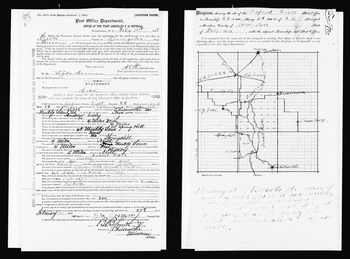 : 1888 Report of Site Location for Cisco Post Office
: 1888 Report of Site Location for Cisco Post Office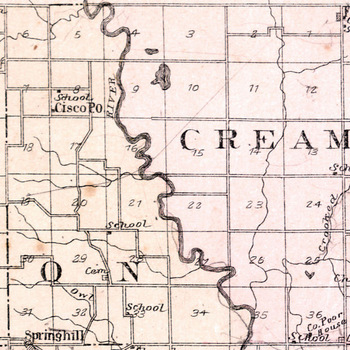 : 1896 Livingston County Map
: 1896 Livingston County Map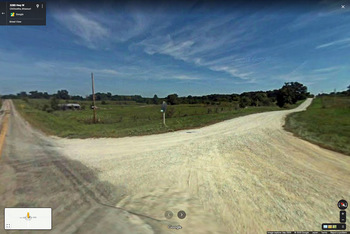 : Google maps, Cisco, MO
: Google maps, Cisco, MO2020-10-23 09:00
コメント(0)
Cisco, Cisco, Cisco, part 13 – Cisco, Virginia [Column_Cisco Township]
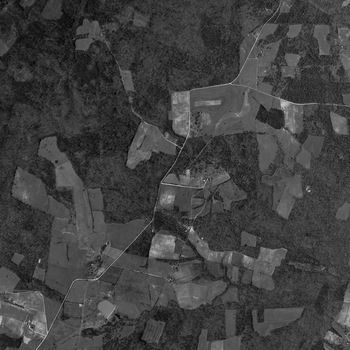 : 1953 USGS Aerial Photo showing the part of Mecklenburg County, VA
: 1953 USGS Aerial Photo showing the part of Mecklenburg County, VAI’m trying to build the N scale replica of the town of Cisco, Utah circa 1970. Accordingly, it’s my routine to search “Cisco” on the web, but it goes wrong most of the time bothered by “San Francisco” or “Cisco Systems”. Sometimes, “Cisco, Texas” gets in my way. Thus, I was wondering how many “Cisco”s are there in the United States. My recent research during these Stay Home days revealed some of them. Let me introduce these places named Cisco as a sideshow for my Town of Cisco posts.
Cisco, Mecklenburg, Virginia: the post office at Cisco, VA is said to be located in the northern part of Mecklenburg County, east of Chase City, near Scotts Crossroad(P.O.) or Drapersville(P.O.)[1]. And, the community of Cisco was listed as a “post village in Mecklenburg County” in 1904 Gazetteer of Virginia[2]. But the exact place of Cisco P.O. or the community of Cisco is missing today. The leading role of the region was farming and the nearest rail connection was Southern Railway at Chase City.
The Cisco Post Office was operated between 1893 and 1906[3]. According to the 1892 Report of Site Location, the post office was going to be located along Scotts Crossroads near the State border.
Joseph Allen Love(1862 – 1903) was the original postmaster[3, 4]. Joseph might also operate a store because the 1900 Census records him as salesman. Charles Hiram Harris(1875 – 1951) was the second postmaster since 1899. William Love Boswell(1849 – 1906) was the third and the last postmaster between 1903 and 1906[5].
Joseph Love married Ida Camilla Boswell(1862 – 1946), a sibling of William Boswell. Charles Harris later married Mary Love Boswell(1894 – 1978), a niece of William Boswell. And, William Boswell himself married Mary Caroline "Carrie" Love(1866 – 1956), a sibling of Joseph Love. Accordingly, the family relationship between the successive postmasters was strong.
A settlement or homestead named J. Boswell is found in both the 1860 and 1870 Map of Mecklenburg County Virginia, along Scotts Crossroads near the State border[6, 7].
A settlement named Boswell must have been tied to a Boswell family, and the Boswell family is tied to the Cisco Post Office. The head of the Boswell family including young William in the 1860 Census was Joseph Boswell(1823 – 1899). Accordingly, I believe that the settlement named J.Boswell appears in 1860 and 1870 Map of Mecklenburg County is the "post village" of Cisco.
After the closure of the Cisco Post Office, letters were forwarded to nearby Reddirt Post Office[3]. However, unfortunately, Reddirt is also the missing place[8]. Nearest school from Cisco/J.Boswell seemed the Concord School at GPS coordinates 36.812643, -78.384164[9].
revised, Dec. 23, 2022
[1] Gilliam, Grrald Tate, (1998) Mecklenburg County, Virginia Post Offices 1794 – 1970, The SouthSider, Charlotte County Branch of The Association for the Preservation of Virginia Antiquities;
[2] Gannett, Henry, (1904) A Gazetteer of Virginia, United States Department of the Interior;
[3] Forte, Jim, Mecklenburg County, Virginia Post Offices, Jim Forte Postal History;
[4] 1894 Official Register of the United States, United States Department of the Interior;
[5] 1903 Official Register of the United States, United States Department of the Interior;
[6] 1860 Map of Mecklenburg County Virginia, Library of Congress;
[7] 1870 Map of Mecklenburg County Virginia, The Chase City Progress;
[8] Caknipe, John, Jr., (2014) Southside Virginia Chronicles, Arcadia Publishing
[9] Feature Detail Report for: Concord School (historical);
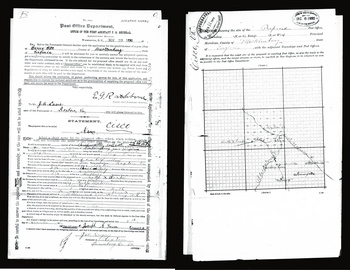 : 1892 Report of Site Location for Cisco Post Office
: 1892 Report of Site Location for Cisco Post Office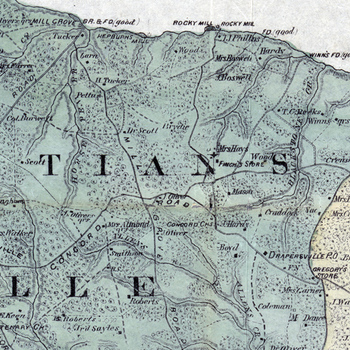 : 1870 map of Mecklenburg County
: 1870 map of Mecklenburg County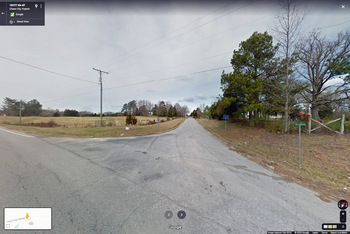 : Google maps, Cisco, VA
: Google maps, Cisco, VA2020-10-30 09:00
コメント(0)
Cisco, Cisco, Cisco, part 14 – Cisco, Tennessee [Column_Cisco Township]
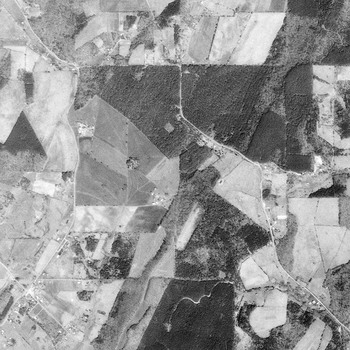 : 1976 USGS Aerial Photo showing the part of McMinn County, TN
: 1976 USGS Aerial Photo showing the part of McMinn County, TNI’m trying to build the N scale replica of the town of Cisco, Utah circa 1970. Accordingly, it’s my routine to search “Cisco” on the web, but it goes wrong most of the time bothered by “San Francisco” or “Cisco Systems”. Sometimes, “Cisco, Texas” gets in my way. Thus, I was wondering how many “Cisco”s are there in the United States. My recent research during these Stay Home days revealed some of them. Let me introduce these places named Cisco as a sideshow for my Town of Cisco posts.
Cisco, McMinn, Tennessee: the post office at Cisco, TN is said to be located near the abandoned cemetery called Old Morrison Burial Grounds at Clearwater, north of Rock Creek and west of Niota[1, 2]. However, unfortunately, the exact place of the post office is missing today. The leading role of the region was farming and the nearest rail connection was Southern and L&N at Athens.
The Cisco Post Office was operated for only a year and a half between Sep. 14, 1901, and Feb. 28, 1903[3, 4]. Lewis Webb Wattenbarger(1874 – 1962) was the sole postmaster. According to 1901 Report of Site of Location, the post office was located along the road between Athens and Sewee. However, unfortunately, the change of road alinements makes it difficult to identify the exact site today: Old Mt. Verd Road can go back to at least 1887 according to the USGS map, but nearby Clearwater Road (County Rd 172) is a relatively new road at least from 1936. Accordingly, the Cisco Post Office may have been located along Old Mt. Verd Road.
The Old Morrison Burial Grounds is located at the back of the farm at 1152 County Rd 172 owned by William Bruce Henry Sr.(1884 ー 1967), later by Creed Foster Bohannon(1910 ー 1996)[5, 6]. Here rest four Stanton family members including Lewis Stanton Jr.(1816 − 1885) who is the great-grandfather of Creed[7].
Lewis Stanton Jr.'s son John Franklin Stanton(1851 − 1930) married Mary Ann Wattenbarger(1859 − 1939). Mary Ann's grandfather Michael Wattenbarger(1804 − 1879) is a great-grandfather of the postmaster Lewis. Accordingly, there is a relationship between the Stanton family, the Wattenbarger family, and the Old Morrison Burial Grounds. Thus, it may not be strange Cisco Post Office is located near the Old Morrison Burial Grounds.
After the closure of the post office, postmaster Lewis moved to the town of Athens and established the L. W. Wattenbarger’s Department Store.
The nearest school from the post office was the Clearwater School at GPS coordinates 35.52174, -84.64910. The school was operated at least from 1898 to circa 1955[8, 9]. Mary Ann Wattenbarger was one of the pupils in 1899[9].
revised, Dec. 23, 2022
[1] Vaughn, Maudie Mae, The Stanton Story, McMinn County Web genealogy project;
[2] Coad, B. R., (1922) Dispersion of the Boll Weevil in 1921, Department Circular 210, United States Department of Agriculture;
[3] Forte, Jim, McMinn County, Tennessee Post Offices, Jim Forte Postal History;
[4] List of Communities and Known Post Masters, RootsWeb;
[5] Stanton and Dennis Families of East Tennessee, rootsweb.com;
[6] Creed Bohannon, White pages directory, Confidential Reverse Phone Lookup;
[7] Old Morrison Burial Grounds, findagrave.com;
[8] Monroe, Josh, (2019) Visitor Comments, Vintage Aerial;
[9] Ratledge, Sandra, N., Clearwater's First Old Log School in McMinn County, TN, 1898 - 1899, School Days, Golden Rule Days;
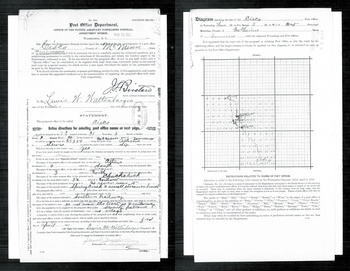 : 1901 Report of Site Location for Cisco Post Office
: 1901 Report of Site Location for Cisco Post Office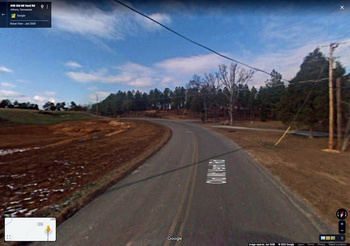 : Google maps, Cisco, TN
: Google maps, Cisco, TN 2020-11-06 09:00
コメント(0)
Cisco, Cisco, Cisco, part 15 – Cisco, Kentucky [Column_Cisco Township]
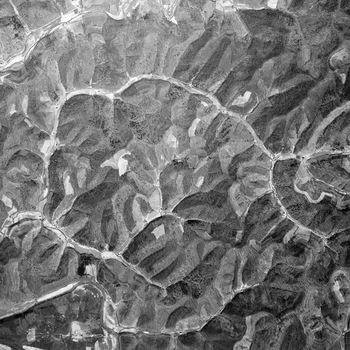 : 1950 USGS Aerial Photo of Cisco, KY
: 1950 USGS Aerial Photo of Cisco, KYI’m trying to build the N scale replica of the town of Cisco, Utah circa 1970. Accordingly, it’s my routine to search “Cisco” on the web, but it goes wrong most of the times bothered by “San Francisco” or “Cisco Systems”. Sometimes, “Cisco, Texas” gets in my way. Thus, I was wondering how many “Cisco”s are there in the United States. My recent research during these Stay Home days revealed some of them. Let me introduce these places named Cisco as a sideshow for my Town of Cisco posts.
Cisco, Magoffin, Kentucky: the post office at Cisco, KY was originally located near the border of Magoffin County and Morgan County on the right bank of Pricy Creek[1]. It was moved to the mouth of Bend Branch on the Licking River at GPS coordinates 37.835973, -83.128635 in 1924[1, 2].
The Cisco Post Office was operated from 1902 to surprising 1998[3]. According to Rennick, the post office was named by and for the original postmaster Hatler(Walter) Cisco(Francisco, 1867 – 1942)[4]. According to Cisco, it was named for Hatler's grandfather George Francisco(Cisco, 1800 – 1867) who was the first settler of the valley[5].
Historical postmasters of the original Cisco Post Office succeeding Hatler were Seymour Howard(1868 – 1957) since 1904, Joseph S Francis(1860 – 1946) since 1906, Henry Clay Franklin(1871 – 1959) since 1911 to its temporal closure in 1914[1].
After the relocation, James Robin Cisco(1865 – 1939), a brother of Hatler, was the postmaster since 1924, Kelly B Arnett(1896 – 1976) since 1925, Reuben B Arnett(1891 – 1973) since 1926, Willie Lovely(1888 – 1956) since 1927, Virgie O Francis(1912 – 1989) since 1944, and Beatrice Lykins Arnett(1921 – 1996) since 1953. After the closure of the post office, letters are forwarded to the post office at Salyersville.
The original location of the community of Cisco is considered to be on the head of the Pricy Creek where George and Elizabeth Robinett(1808 – 1880) Francisco(Cisco), the grandparents of Hatler, were settled in 1860[5].
As far as I researched, Cisco, as the name of the community, doesn't appear until in 1906 Land McNally map, and in 1912 local newspaper[6, 7]. George and Elizabeth Francisco, grandparents, David Crockett Cisco(1840 – 1916), father, Ellen Catherine Francisco Coffee(1854 – 1913), an aunt, Lester Cisco(1907 – 1908), little son, and other Hatler Cisco relatives rest at the original settlement, today called as the Cisco Cemetery[8].
The community of Cisco today is moved a little down the Pricy Creek from the original settlement, about a mile and a half north from the relocated post office at GPS coordinates 37.8525895, -83.1351727[9].
The Lower Pricy School, the nearest school from Cisco community today, was open at least between 1953 and 1954[10]. The schoolhouse itself can be seen in the 1950 aerial photo above.
Bend (Ben) Branch School, the nearest school from the moved Cisco Post Office, was open at least in 1953 according to the USGS map, White Oak, KY. The schoolhouse itself can also be seen in the 1950 aerial photo above.
There used to be another school up the Pricy Creek, near the the original settlement, named Head of Pricy (Upper Pricy) School according to the 1953 USGS map[11]. This schoolhouse was built by Hatler and George Samuel Cisco(1880 – 1965), a cousin of Hatler, in 1912[12].
Today, only the post office structure survives as you can see in Google street view shown below[13].
Redwine, the original southern terminus of Morehead & North Fork Railroad until 1933, was located 13 miles northwest of Cisco[14]. Nine miles northwest was Licking River, the northern terminus of Ohio & Kentucky Railroad until 1933. 13 miles south was the Loyalton depot of Big Sandy and Kentucky River Railroad, later C&O, CSX, and eventually R.J. Corman until 2004.
[1] Rennick, Robert M., (2016) Magoffin County Place Names, Morehead State University;
[2] Feature Detail Report for: Cisco, USGS;
[3] Forte, Jim, Magoffin County, Kentucky Post Offices, Jim Forte Postal History;
[4] Rennick, Robert M., (1984) Kentucky Place Names, University Press of Kentucky;
[5] Cisco, Allen Newton, (1954) George Cisco, findagrave.com;
[6] 1906 Kentucky map, Land McNally;
[7] Feb. 16 1912 Kentucky Mountaineer;
[8] Cisco Cemetery, findagrave.com;
[9] USGS Feature Detail Report for: Cisco;
[10] Apr. 22, 1954 Licking Valley Courier;
[11] Jan. 3, 1935 Licking Valley Courier;
[12] Mar. 8, 1912 Kentucky Mountaineer;
[13] Gallagher, J, (1978) Cisco, KY post office, Post mark Collectors Club;
[14] Utopia – Quest for the Perfection, part 1, Boxcar Red Collection;
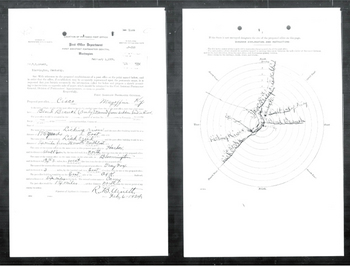 : 1924 Report of Site of Location for Cisco Post office
: 1924 Report of Site of Location for Cisco Post office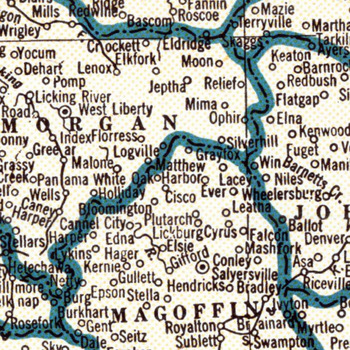 : 1931 Geographical Publishing Company map of kentucky
: 1931 Geographical Publishing Company map of kentucky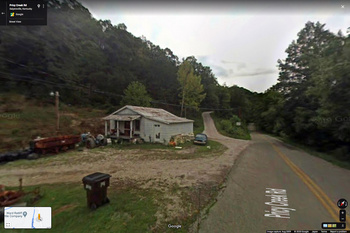 : Google maps, Cisco, KY
: Google maps, Cisco, KY2020-11-13 09:00
コメント(0)
Cisco, Cisco, Cisco, part 16 – Cisco, Wisconsin [Column_Cisco Township]
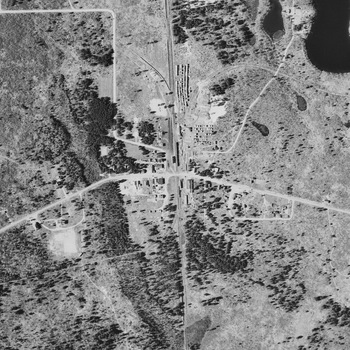 : 1938 USGS Aerial Photo of Stateline, WI
: 1938 USGS Aerial Photo of Stateline, WII’m trying to build the N scale replica of the town of Cisco, Utah circa 1970. Accordingly, it’s my routine to search “Cisco” on the web, but it goes wrong most of the time bothered by “San Francisco” or “Cisco Systems”. Sometimes, “Cisco, Texas” gets in my way. Thus, I was wondering how many “Cisco”s are there in the United States. My recent research during these Stay Home days revealed some of them. Let me introduce these places named Cisco as a sideshow for my Town of Cisco posts.
Cisco Chain of Lakes, Vilas, Wisconsin/Gogebic, Michigan: the Cisco Post Office was located on E Duck Lake Rd today at the town of Stateline, WI opposite the Milwaukee, Lake Shore & Western Railway’s State Line, later Land O’Lakes station located between Monico, WI and Watersmeet, MI[1, 2]. The leading role of the region was forestry, later tourism.
The Cisco Post Office was operated between 1908 and 1914[3]. Charles Augustus “Chas” Bent(1856 – 1932) was the original and the sole postmaster[4]. The origin of the name is maybe the Cisco Lake or Cisco Branch of the Ontonagon River both within the state of Michigan; Cisco is a French Canadian borrowing from Ojibwa for a kind of whitefish called Lake Herring, Coregonus artedii. After the closure, letters were forwarded to Donaldson.
The MLS&W line reached the WI/MI border in 1883, herewith the State Line station was established same year[5].
Rudolf Otto Mill, established in 1886 and succeeding Mason-Donaldson Co. Mill since 1905 on the south shore of Mill Lake attracted laborers to form the community later called Donaldson[6]. It centered around the corner of Hwy B and Town Collection Site (Town Garage) Rd today two miles west of the depot[7].
The original State Line Post Office near the depot was operated between 1887 and 1907 at the corner of Hwy B and E Duck Lake Rd today, with Rudolf(Rudolph) Otto(1844 – 1898) as the original postmaster[3].
The State Line Post Office moved to Donaldson in 1907 and operated as Donaldson Post Office with Charles W Fish as the original postmaster[3]. Thus, the Cisco Post Office seems established next year at the town of Stateline. The Donaldson Post Office survived until 1919.
The town of Stateline was incorporated also in 1907. The second State Line Post Office succeeding the Cisco Post Office was established in 1919[3]. The town was renamed to Land O’Lakes in 1948[8]. The post office was also renamed to Land O’Lakes in 1923, and has been operating to this day[3].
There used to be two schools in the area: Donaldson School and "Michigan" School on Duck Lake Rd in MI. Donaldson School was established in 1907. Succeeding Land O'Lakes School was founded in 1931. "Michigan" Schoolhouse was later moved to Watersmeet, MI, and became the Minnie’s Cafe. However, unfortunately, it seems torn down in 2014.
Construction of the permanent low dam at the Cisco Lake outlet to the Cisco Branch of the Ontonagon River in 1931 created the chain of interconnected lakes called Cisco Chain of Lakes today[9]. Since, the region became a summer vacation destination well known for fishing, boating, and other outdoor activities.
Until 1971, Flambeau “400”, later Bi-Level Flambeau “400”, eventually trains #153 and #216 connected Land O’Lakes and Chicago. Oct. 1965 Trains magazine represented the Flambeau “400” in the "Would you believe it?" column as it was consisted of only a E7 and a bi-level coach. The MLS&W line, eventually Chicago & Northwestern Railway Eagle River Subdivision remained in operation until 1981[8].
Once, a 5.4 mile branch diverted from Stickley, MI reached C&NW Cisco Lake terminus[10]. The Northern Lakes Special, later Wisconsin Lakes Special, consisted of a FP7, a E7, a coach, and two sleeping cars as of 1960, connected Cisco Lake and Chicago on summer weekend nights between 1917 and 1963[11, 12].
revised, Apr. 29, 2021
revised, May 13, 2021
[1] The Town of Land O’Lakes Formerly Stateline & Donaldson, Northern Waters Museum;
[2] Chicago & Northwestern Eagle River Subdivision, Railroad Operating Information;
[3] Forte, Jim, Vilas County, Wisconsin Post Offices, Jim Forte Postal History;
[4] 1909 Official Register of the United States, United States Department of the Interior;
[5] Wisconsin Railroad Timeline: 19th Century;
[6] Premo, Dean, (2007) Black Oak Lake Watershed Protection Program: Adaptive Lake Management Plan, Wisconsin Department of Natural Resources;
[7] Jun. 23, 2016 Border Bulletin;
[8] Timeline – 1981, michiganrailroads.com;
[9] Hanchin, Patrick A., (2008) The Fish Community and Fishery of the Cisco Lake Chain, Gogebic County, Michigan and Vilas County, Wisconsin with Emphasis on Walleyes, Northern Pike, and Muskellunge, Fisheries Special Report 47, Michigan Department of natural Resources Fisheries Division;
[10] Location: Cisco Lake, MI, michiganrailroads.com;
[11] Hermolin, Joe, (2016) Antigo's History Linked Closely To The Railroad, Antigo Daily Journal;
[12] Apr. 1961 photo section, Trains, Kalmbach
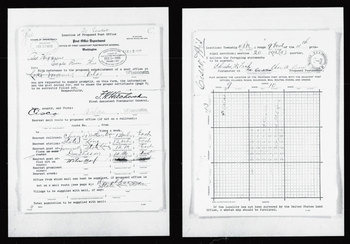 : 1907 Report of Site of Location for Cisco Post Office
: 1907 Report of Site of Location for Cisco Post Office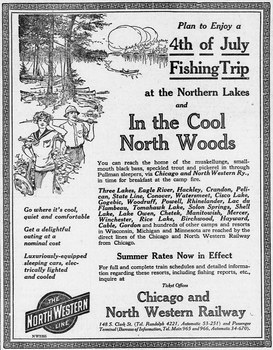 : Jun. 28, 1912 Chicago Examiner
: Jun. 28, 1912 Chicago Examiner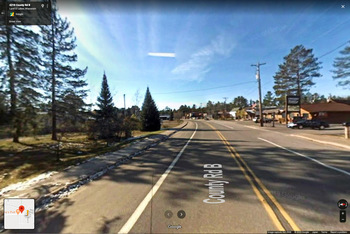 : Google maps, Cisco, WI
: Google maps, Cisco, WI2020-11-20 09:00
コメント(0)
Cisco, Cisco, Cisco, part 17 – Cisco, Oklahoma [Column_Cisco Township]
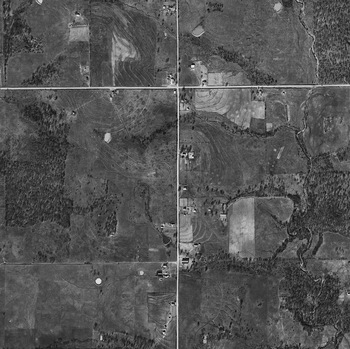 :1949 USGS Aerial Photo of Cisco, OK
:1949 USGS Aerial Photo of Cisco, OKI’m trying to build the N scale replica of the town of Cisco, Utah circa 1970. Accordingly, it’s my routine to search “Cisco” on the web, but it goes wrong most of the time bothered by “San Francisco” or “Cisco Systems”. Sometimes, “Cisco, Texas” gets in my way. Thus, I was wondering how many “Cisco”s are there in the United States. My recent research during these Stay Home days revealed some of them. Let me introduce these places named Cisco as a sideshow for my Town of Cisco posts.
Cisco, McCurtain, Oklahoma: the post office at Cisco, OK was located near the Texas border, five miles west of Idabel. The leading role of the region was farming and the nearest rail connection was St. Louis - San Francisco Railway at Idabel.
The Cisco Post Office was operated only between May 1913 and July 1916[1]. It was the last new Cisco P.O. to this day in the United States. Roy Columbus Clements(1882 – 1959) was the original postmaster, succeeded by William Henry Hunt(1862 – 1948) in Jan. 1916[2]. After the closure, letters were forwarded to Idabel Post Office.
According to the 1910 Census records, five doors apart from the farmer Roy Clements' dwelling in Township 3 was a salesman Andrew Robert "Andy" Hughes'(1857 – 1940) dwelling. The local newspaper tells us that A. R. Hughes' Store was destroyed by the 1917 tornado[3]. Accordingly, Hughes might establish the store which later became known as the Cisco Store. However, unfortunately, Hughes went bankrupt in 1918.
The said Cisco Store was at the northwest corner of State Hwy 37, formerly Rural Route 1, and Cisco Rd crossroads, and was the landmark of the region[4]. The Store had been operating at least between 1918 and 1961 [5, 6]. "Moreland & Magan" was the official name of the Store in 1919[7]. Lewis Flecher Moreland(1868 ー 1935) and George Cicero Magan(1862 ー 1941) might be the entrepreneurs. Eventually, it might be J&J Grocery Store operated by JoAnn Scott and Johnna Smith[8].
The Cisco School was operated from 1907, after Oklahoma Statehood, to 1958 at GPS coordinates 33.8884418, -94.9127204 [9, 10, 11, 12]. 1974 USGS map, Texarkana, TX still shows the schoolhouse but does not in 1986 edition.
Today, the skeleton signboard of the Cisco Store only rises at the Cisco Rd crossroads as you can see in the Google maps street view below.
revised, Dec. 23, 2022
[1] Forte, Jim, McCurtain County, Oklahoma Post Offices, Jim Forte Postal History;
[2] Shirk, George H., (1966) The Post offices of Oklahoma, 1907 to 1965, Vol. XLIV, No. 1, The Chronicles of Oklahoma, The Oklahoma historical Society;
[3] Feb. 24, 1917 McCurtain Gazette;
[4] okienarc, (2005) Re: Cleveland Frazier....Kirk / Cisco Township...Where are these located?, Message Boards, ancestry.com;
[5] Aug. 31, 1918 McCurtain Gazette;
[6] Dec. 9, 1961 McCurtain Gazette
[7] Dec. 13, 1919 McCurtain Gazette;
[8] Scott, JoAnn, (2008) Guest Book, BOBBY DEWAYNE SHEPHERD, findagrave.com;
[9] Feature Detail Report for: Cisco School, USGS;
[10] Nov. 18, 1914 McCurtain Gazette
[11] Jun. 28, 1958 McCurtain Gazette
[12] 1956 USGS map, Texarkana, TX
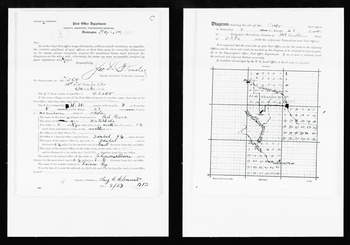 : 1913 Report of Site Location for Cisco Post Office
: 1913 Report of Site Location for Cisco Post Office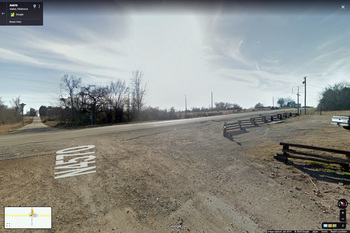 : Google maps, Cisco, OK
: Google maps, Cisco, OK2020-11-27 09:00
コメント(0)
Cisco, Cisco, Cisco, part 18 – Conclusion and appendix [Column_Cisco Township]
I’m trying to build the N scale replica of the town of Cisco, Utah circa 1970. Accordingly, it’s my routine to search “Cisco” on the web, but it goes wrong most of the time bothered by “San Francisco” or “Cisco Systems”. Sometimes, “Cisco, Texas” gets in my way. Thus, I was wondering how many “Cisco”s are there in the United States. My recent research during these Stay Home days revealed some of them. Let me introduce these places named Cisco as a sideshow for my Town of Cisco posts.
We have reviewed 15 communities named Cisco scattered all over the Contiguous United States. Eight of them had Cisco Station/Depot, nine of them had relations with railroads, all the communities had Cisco Post Office, and seven of them were said to be named for a person named Cis/Cisco/Sisco/Francisco.
However, interestingly, I encountered several "Cisco"s beside those communities we have reviewed. Let me introduce some of them:
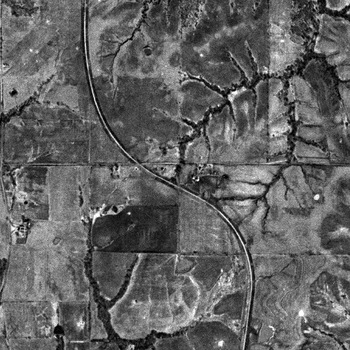 : 1950 USGS Aerial Photo showing part of Harrison County, MO
: 1950 USGS Aerial Photo showing part of Harrison County, MO
Cisco School, Harrison, Missouri
The Cisco School at Harrison County in Missouri did exist near the Iowa/Missouri border at GPS coordinates 40.52916, -93.90883[1]. The lack of both station and post office caused the place to slip through our dragnet. I could neither find the origin nor the exact place of the community of Cisco. Accordingly, I represent the USGS Aerial Photo showing the former Cisco School site.
1876 Harrison County Map shows "School No. 7" at the corner of the plat owned by Pascal Jennings Richardson(1873 – 1963), which was next to the plat owned by George Francisco(1835 – 1879) on the west[2]. The school might be named for George. 1947 USGS map, Lamoni, IA shows the school as "Cisco Sch".
The one-room school was equipped with a coat room, library, a well for water, and two outhouses. Several families seem inhabited around the school[3]. Mails were carried from Blythedale, four miles south of the school.
Kansas City, St. Joseph & Council Bluffs Railroad built the line from Chariton, IA to St. Joseph, MO. The section through Cisco School was completed in 1880, but trains never stopped here. The line became Chicago Burlington & Quincy in 1901, eventually Burlington Northern in 1970, but was abandoned in 1981.
[1] USGS Feature Detail Report for: Cisco School;
[2] 1876 Harrison County Map;
[3] Fowler, Mildred Irene, Mildred/Mickey Early Childhood;
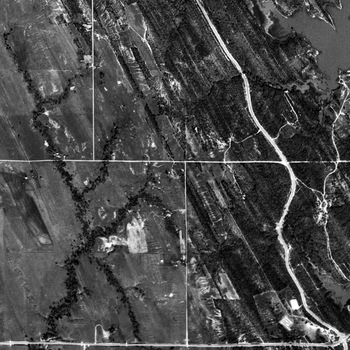 : 1955 USGS Aerial Photo showing part of Carter County, OK
: 1955 USGS Aerial Photo showing part of Carter County, OK
Cisco School, Carter, Oklahoma
Eight out of fifteen "Cisco"s had a "Cisco Road" to reach the namesake community. Accordingly, unconfirmed "Cisco Road" may lead us to the still undiscovered "Cisco".
The Cisco Road found at the south of Ardmore, Oklahoma even had the namesake school along the road: the school was located on the southside of the Cisco Road between Elephant Rock Road and Lake Murray Road[4]. It was at least open between 1906 and 1923[5, 6]. The 1923 photo of the school can be seen on the web[6].
It is said that the schoolhouse became the Lake Murray Inn in the 30s after the closure[4]. But the Inn structure in the photo looks somewhat larger than the particular schoolhouse[7].
However, unfortunately, I could neither find the origin nor the exact place of the community of Cisco. I’m afraid there wasn’t such a community. Or, it may be sunk in the man-made Lake Murray created in 1938. Accordingly, I represent the USGS Aerial Photo showing the Cisco Road and the former Cisco School site.
[4] Jun. 26, 2008 This and That Newsletter, OklahomaHistory.Net;
[5] Nov. 7, 1906 The Daily Admoreite;
[6] Cisco School, District 17, in southeastern Carter County, Oklahoma Historical Society;
[7] Lake Murray Inn among the oaks, OklahomaHistory.Net;
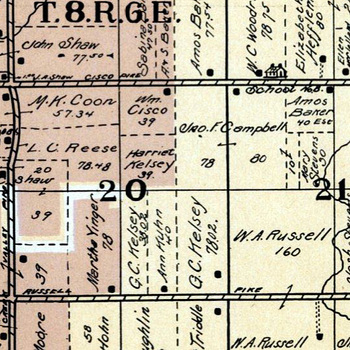 : 1900 Shelby County Map
: 1900 Shelby County Map
Cisco Road, Shelby, Ohio
Of course, not all the "Cisco Road"s lead us to communities named Cisco. For example, Cisco Road at Shelby County in Ohio never reached a community named Cisco but reached the Francisco homestead.
1875 Turtle Creek Township, Shelby County Map shows the road but without a name. Also is that there was no landowner named Cisco or Francisco.
1900 Turtle Creek Township, Shelby County Map shows the road named "Cisco Pike"[8]. And, William H. Francisco(1841 – 1901) owned a plat and a house on the south side of the namesake road. Likewise, William A. Russell(1837 – 1914) owned plats and a house along the "Russell Pike" ran parallel to "Cisco Pike".
Accordingly, the roads in Turtle Creek Township must have been named for the landowner/inhabitant these days. Both the name of the road survive to this day.
[8] 1900 Turtle Creek Township, Shelby County Map, American Atlas Company;
Cisco Road, Macoupin, Illinois
Another Cisco Road is found at the north of Carlinville crossing the former Gulf Mobile & Ohio Railroad, recently Union Pacific Railroad. The road doesn't lead us to the community of Cisco but to the Central Illinois Steel Company located at 21050 Route 4 Carlinville. The company was founded in 1972 and has a spur diverting from UP main.
Cisco Street, Bakersfield, California
There are even more streets/roads named Cisco, but I believe this Cisco St is one of the shortest in the United States. This dead-end street stretches only about sixty yards according to Google maps. The history of the street seems also relatively short: as far as I researched, it first appears in the 1970 USGS map, Lamont, CA. UP/BNSF, former SP/ATSF industrial spur parallels the street 600 yards to the west.
Cisco, Nantucket, Massachusetts
Cisco, Nantucket, Massachusetts is a beach rather than a community located in Nantucket Island off Cape Cod. Once, the Nantucket Central Railroad served the island but never reached this part of the island. The history of both the name of the places "Cisco" and "Cisco beach" seems relatively short; they first appear in the 1972 USGS map, Nantucket, MA.
Cisco, Garden, Nebraska
The community of Lisco, Garden, Nebraska is erroneously shown with the name "Cisco" in the 2000 United States Census. The exact Lisco, NE is named for the landowner Ruben Lisco(1858 – 1935). Union Pacific line runs through Lisco.
The Google map below shows all the "Cisco"s reviewed in preceding posts.
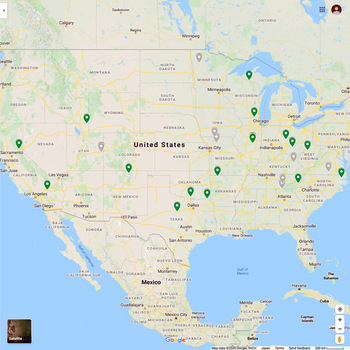 : Google map of Cisco, USA
: Google map of Cisco, USA
We have reviewed 15 communities named Cisco scattered all over the Contiguous United States. Eight of them had Cisco Station/Depot, nine of them had relations with railroads, all the communities had Cisco Post Office, and seven of them were said to be named for a person named Cis/Cisco/Sisco/Francisco.
However, interestingly, I encountered several "Cisco"s beside those communities we have reviewed. Let me introduce some of them:
 : 1950 USGS Aerial Photo showing part of Harrison County, MO
: 1950 USGS Aerial Photo showing part of Harrison County, MOCisco School, Harrison, Missouri
The Cisco School at Harrison County in Missouri did exist near the Iowa/Missouri border at GPS coordinates 40.52916, -93.90883[1]. The lack of both station and post office caused the place to slip through our dragnet. I could neither find the origin nor the exact place of the community of Cisco. Accordingly, I represent the USGS Aerial Photo showing the former Cisco School site.
1876 Harrison County Map shows "School No. 7" at the corner of the plat owned by Pascal Jennings Richardson(1873 – 1963), which was next to the plat owned by George Francisco(1835 – 1879) on the west[2]. The school might be named for George. 1947 USGS map, Lamoni, IA shows the school as "Cisco Sch".
The one-room school was equipped with a coat room, library, a well for water, and two outhouses. Several families seem inhabited around the school[3]. Mails were carried from Blythedale, four miles south of the school.
Kansas City, St. Joseph & Council Bluffs Railroad built the line from Chariton, IA to St. Joseph, MO. The section through Cisco School was completed in 1880, but trains never stopped here. The line became Chicago Burlington & Quincy in 1901, eventually Burlington Northern in 1970, but was abandoned in 1981.
[1] USGS Feature Detail Report for: Cisco School;
[2] 1876 Harrison County Map;
[3] Fowler, Mildred Irene, Mildred/Mickey Early Childhood;
 : 1955 USGS Aerial Photo showing part of Carter County, OK
: 1955 USGS Aerial Photo showing part of Carter County, OKCisco School, Carter, Oklahoma
Eight out of fifteen "Cisco"s had a "Cisco Road" to reach the namesake community. Accordingly, unconfirmed "Cisco Road" may lead us to the still undiscovered "Cisco".
The Cisco Road found at the south of Ardmore, Oklahoma even had the namesake school along the road: the school was located on the southside of the Cisco Road between Elephant Rock Road and Lake Murray Road[4]. It was at least open between 1906 and 1923[5, 6]. The 1923 photo of the school can be seen on the web[6].
It is said that the schoolhouse became the Lake Murray Inn in the 30s after the closure[4]. But the Inn structure in the photo looks somewhat larger than the particular schoolhouse[7].
However, unfortunately, I could neither find the origin nor the exact place of the community of Cisco. I’m afraid there wasn’t such a community. Or, it may be sunk in the man-made Lake Murray created in 1938. Accordingly, I represent the USGS Aerial Photo showing the Cisco Road and the former Cisco School site.
[4] Jun. 26, 2008 This and That Newsletter, OklahomaHistory.Net;
[5] Nov. 7, 1906 The Daily Admoreite;
[6] Cisco School, District 17, in southeastern Carter County, Oklahoma Historical Society;
[7] Lake Murray Inn among the oaks, OklahomaHistory.Net;
 : 1900 Shelby County Map
: 1900 Shelby County MapCisco Road, Shelby, Ohio
Of course, not all the "Cisco Road"s lead us to communities named Cisco. For example, Cisco Road at Shelby County in Ohio never reached a community named Cisco but reached the Francisco homestead.
1875 Turtle Creek Township, Shelby County Map shows the road but without a name. Also is that there was no landowner named Cisco or Francisco.
1900 Turtle Creek Township, Shelby County Map shows the road named "Cisco Pike"[8]. And, William H. Francisco(1841 – 1901) owned a plat and a house on the south side of the namesake road. Likewise, William A. Russell(1837 – 1914) owned plats and a house along the "Russell Pike" ran parallel to "Cisco Pike".
Accordingly, the roads in Turtle Creek Township must have been named for the landowner/inhabitant these days. Both the name of the road survive to this day.
[8] 1900 Turtle Creek Township, Shelby County Map, American Atlas Company;
Cisco Road, Macoupin, Illinois
Another Cisco Road is found at the north of Carlinville crossing the former Gulf Mobile & Ohio Railroad, recently Union Pacific Railroad. The road doesn't lead us to the community of Cisco but to the Central Illinois Steel Company located at 21050 Route 4 Carlinville. The company was founded in 1972 and has a spur diverting from UP main.
Cisco Street, Bakersfield, California
There are even more streets/roads named Cisco, but I believe this Cisco St is one of the shortest in the United States. This dead-end street stretches only about sixty yards according to Google maps. The history of the street seems also relatively short: as far as I researched, it first appears in the 1970 USGS map, Lamont, CA. UP/BNSF, former SP/ATSF industrial spur parallels the street 600 yards to the west.
Cisco, Nantucket, Massachusetts
Cisco, Nantucket, Massachusetts is a beach rather than a community located in Nantucket Island off Cape Cod. Once, the Nantucket Central Railroad served the island but never reached this part of the island. The history of both the name of the places "Cisco" and "Cisco beach" seems relatively short; they first appear in the 1972 USGS map, Nantucket, MA.
Cisco, Garden, Nebraska
The community of Lisco, Garden, Nebraska is erroneously shown with the name "Cisco" in the 2000 United States Census. The exact Lisco, NE is named for the landowner Ruben Lisco(1858 – 1935). Union Pacific line runs through Lisco.
The Google map below shows all the "Cisco"s reviewed in preceding posts.
 : Google map of Cisco, USA
: Google map of Cisco, USA2020-12-04 09:00
コメント(0)



